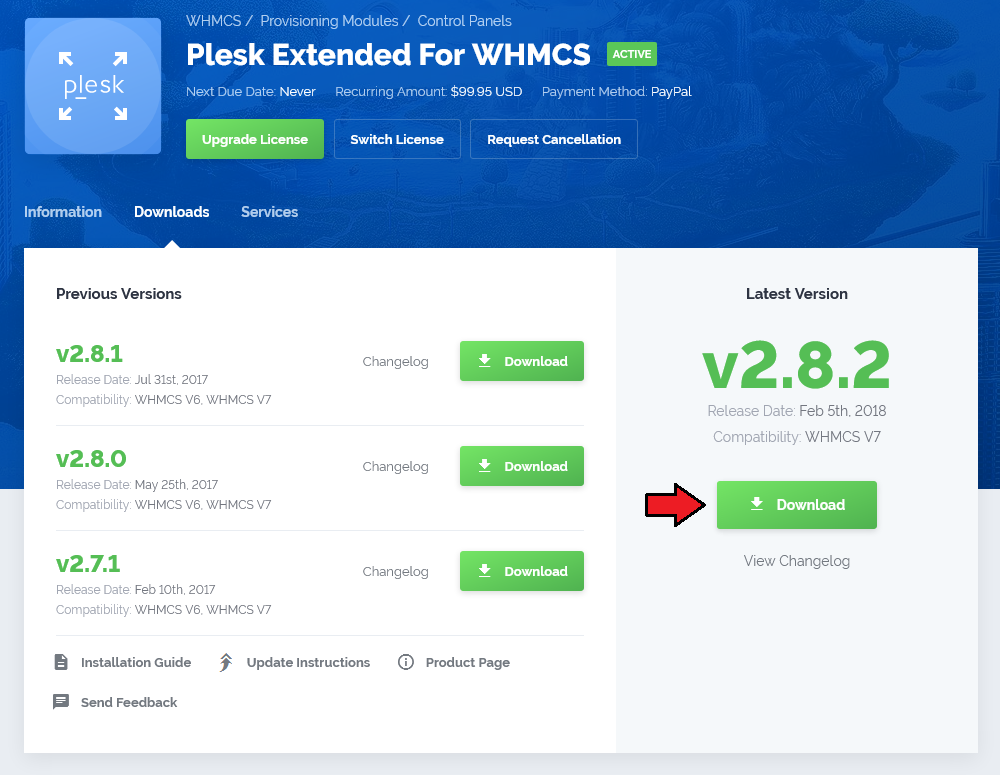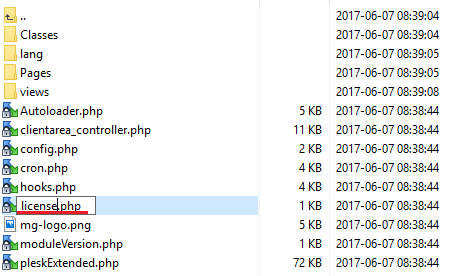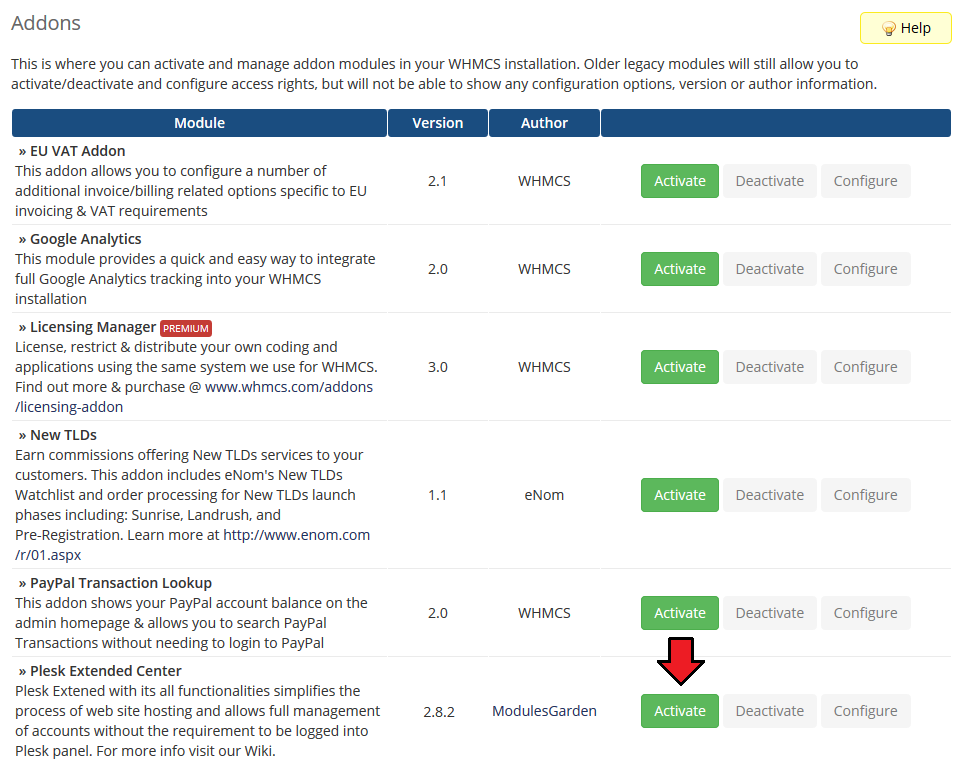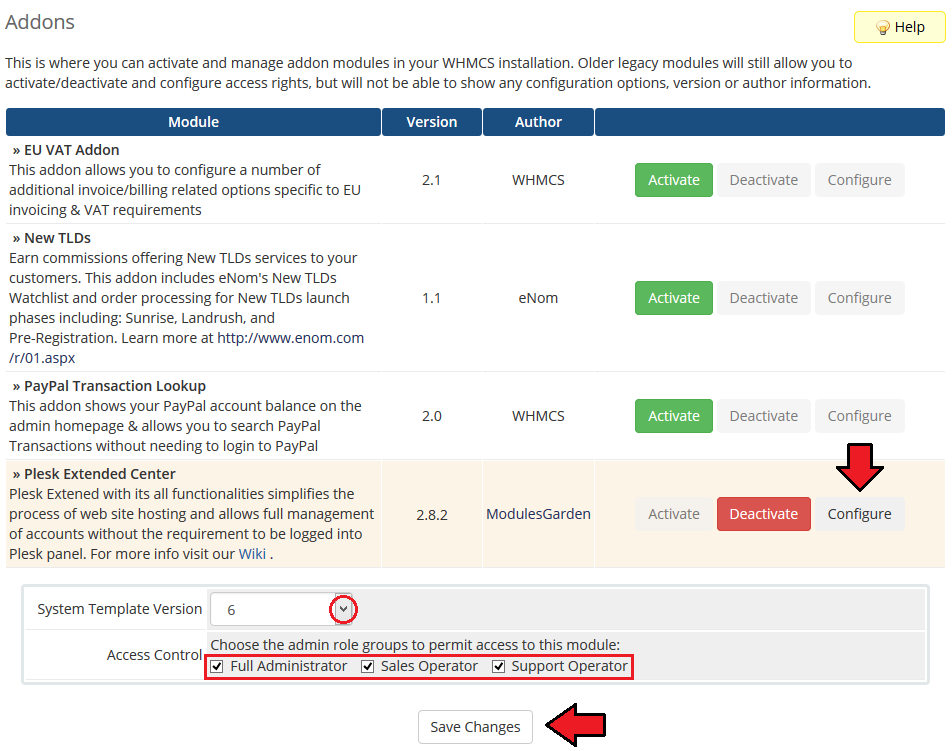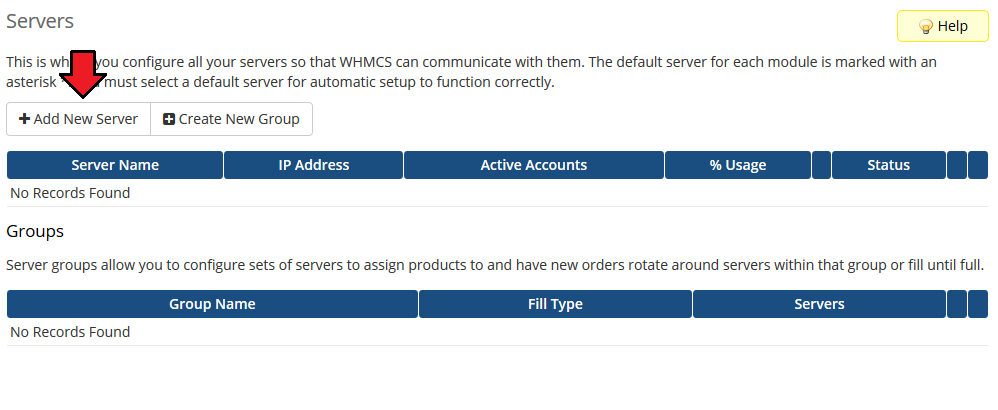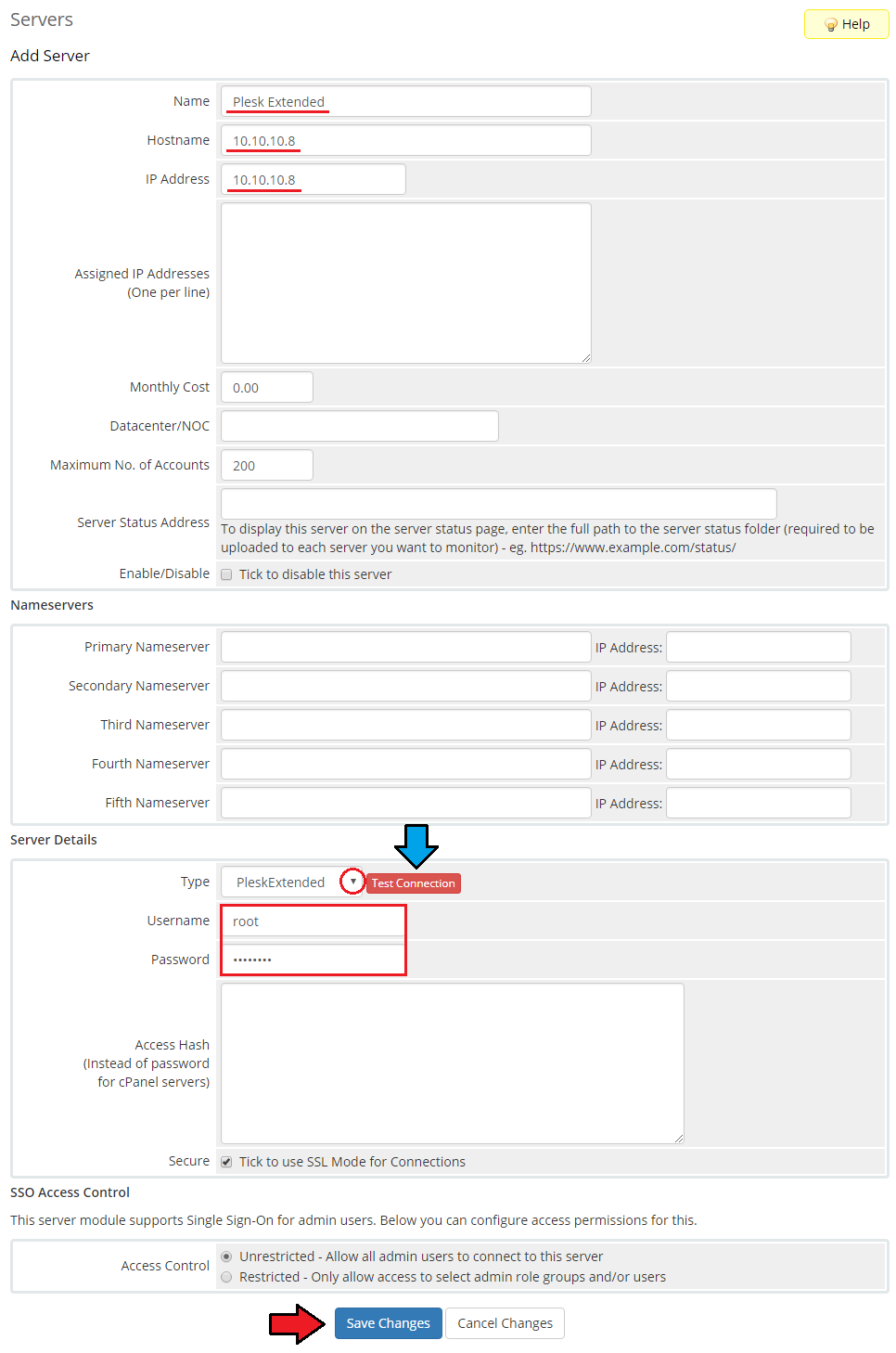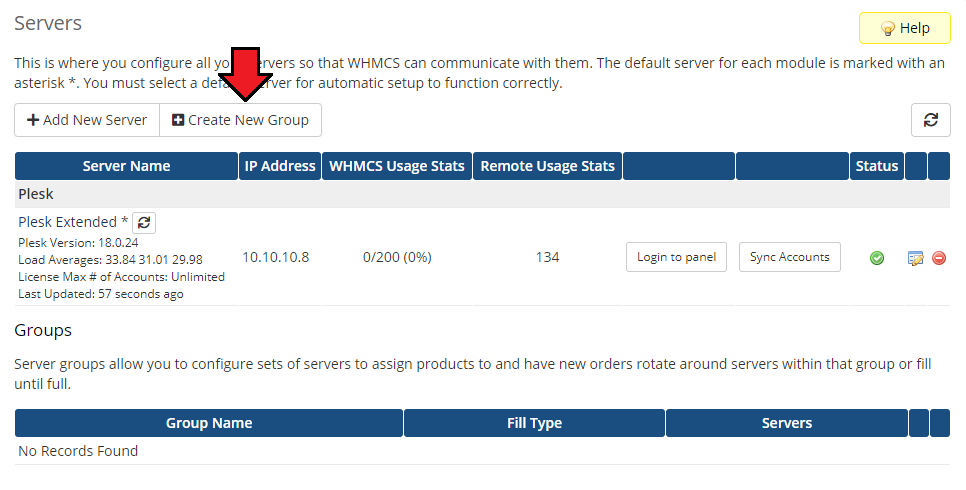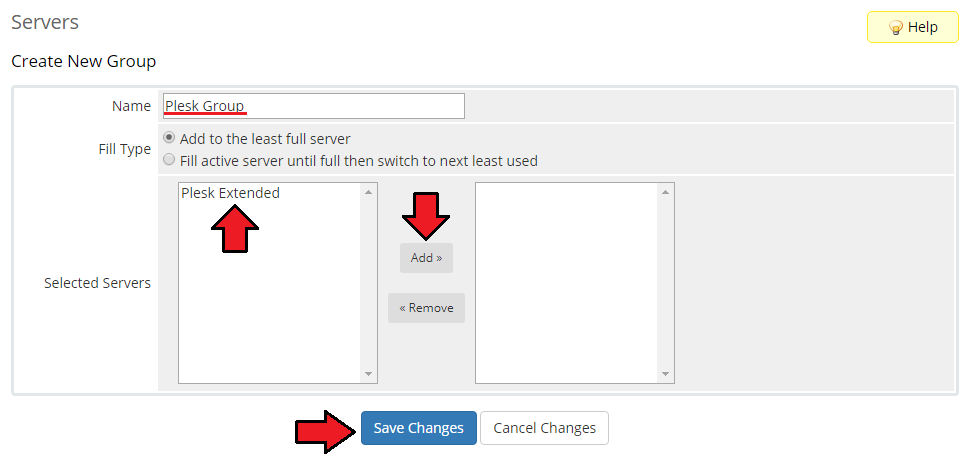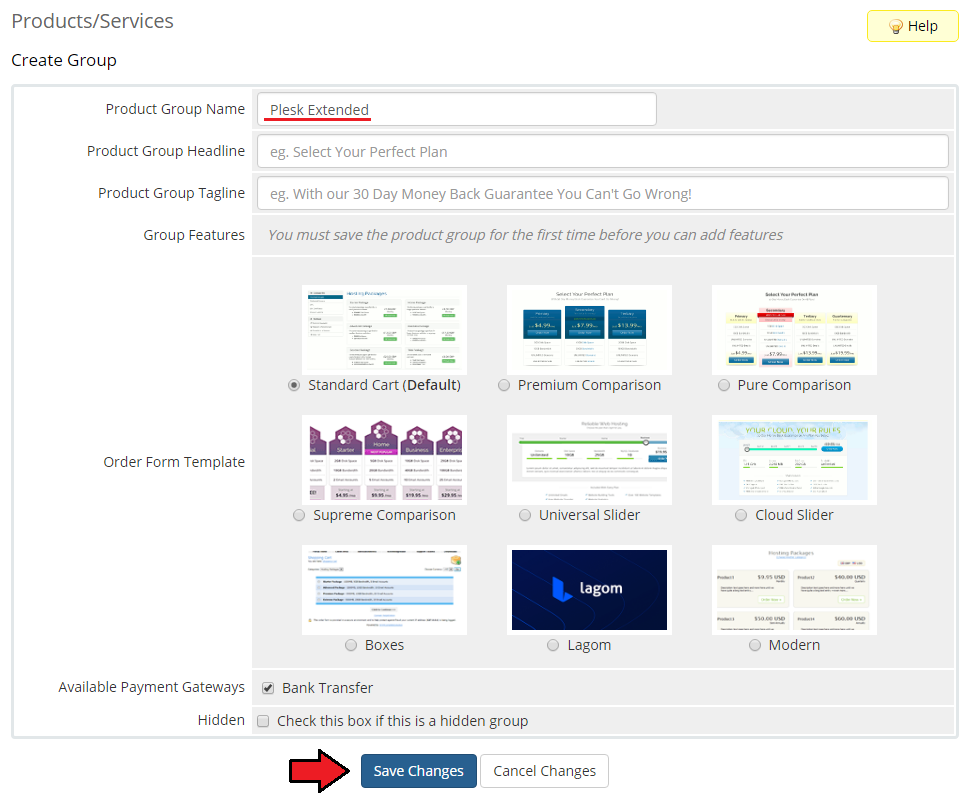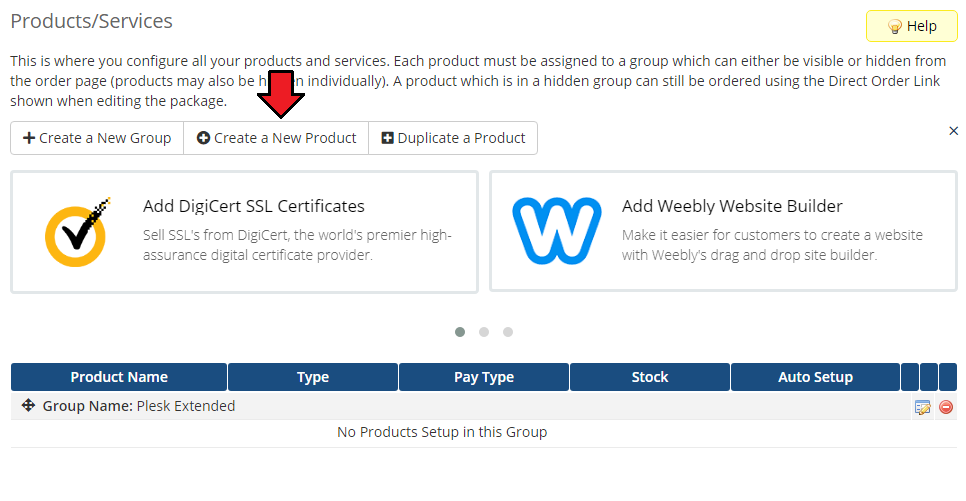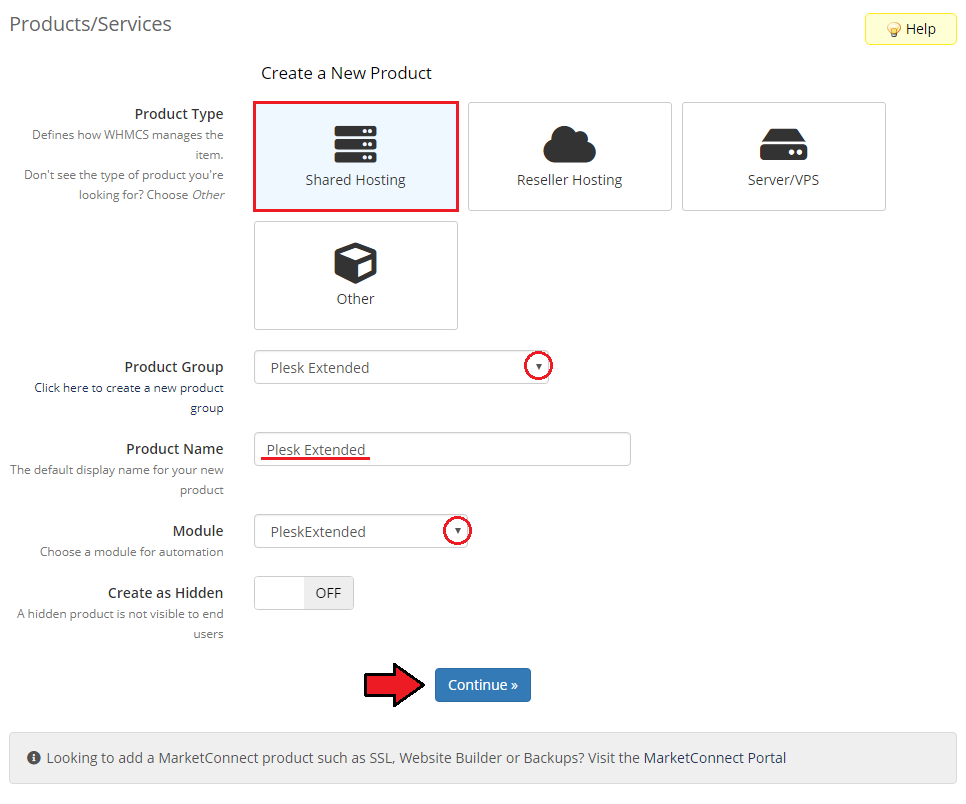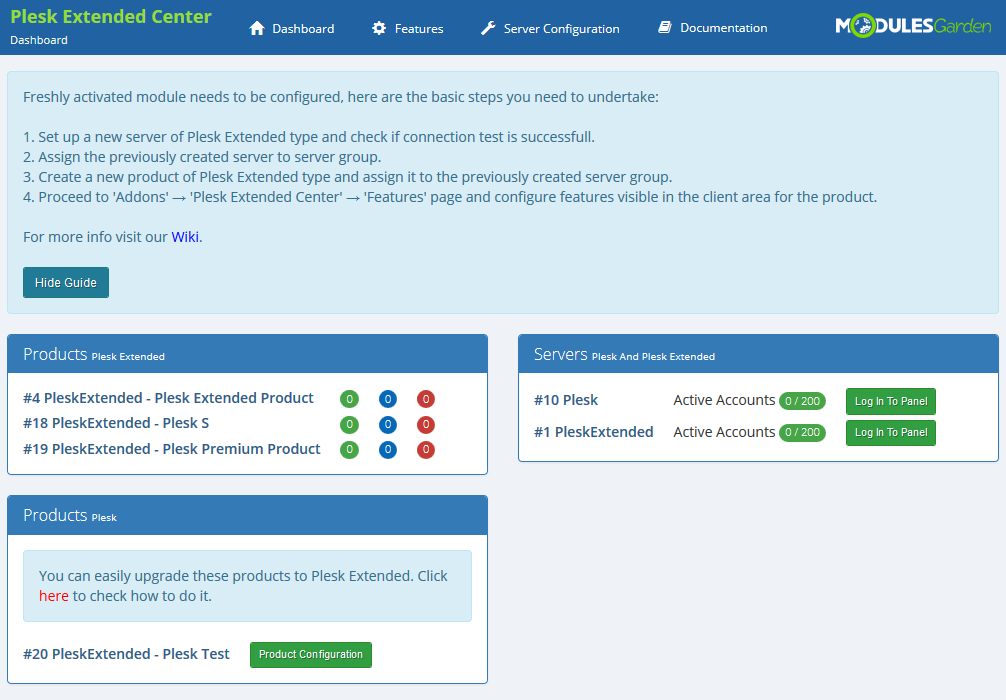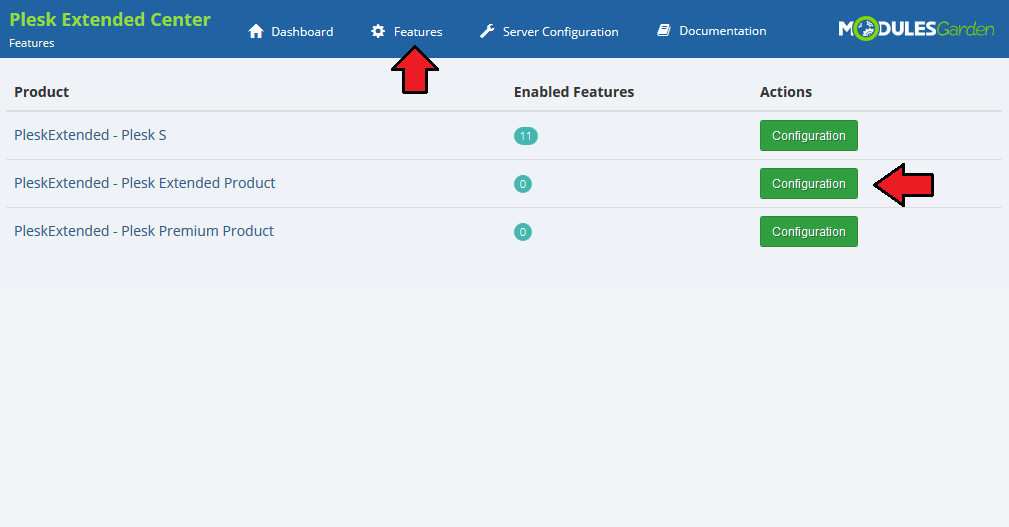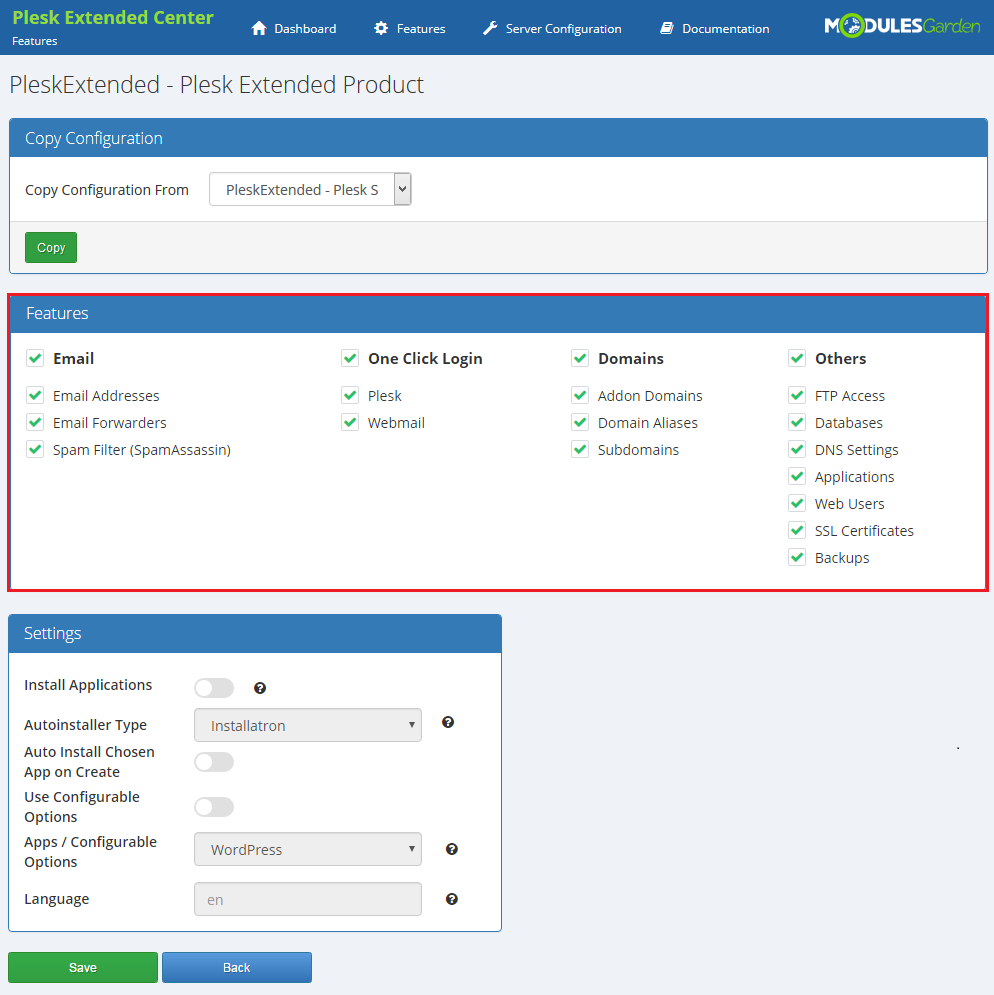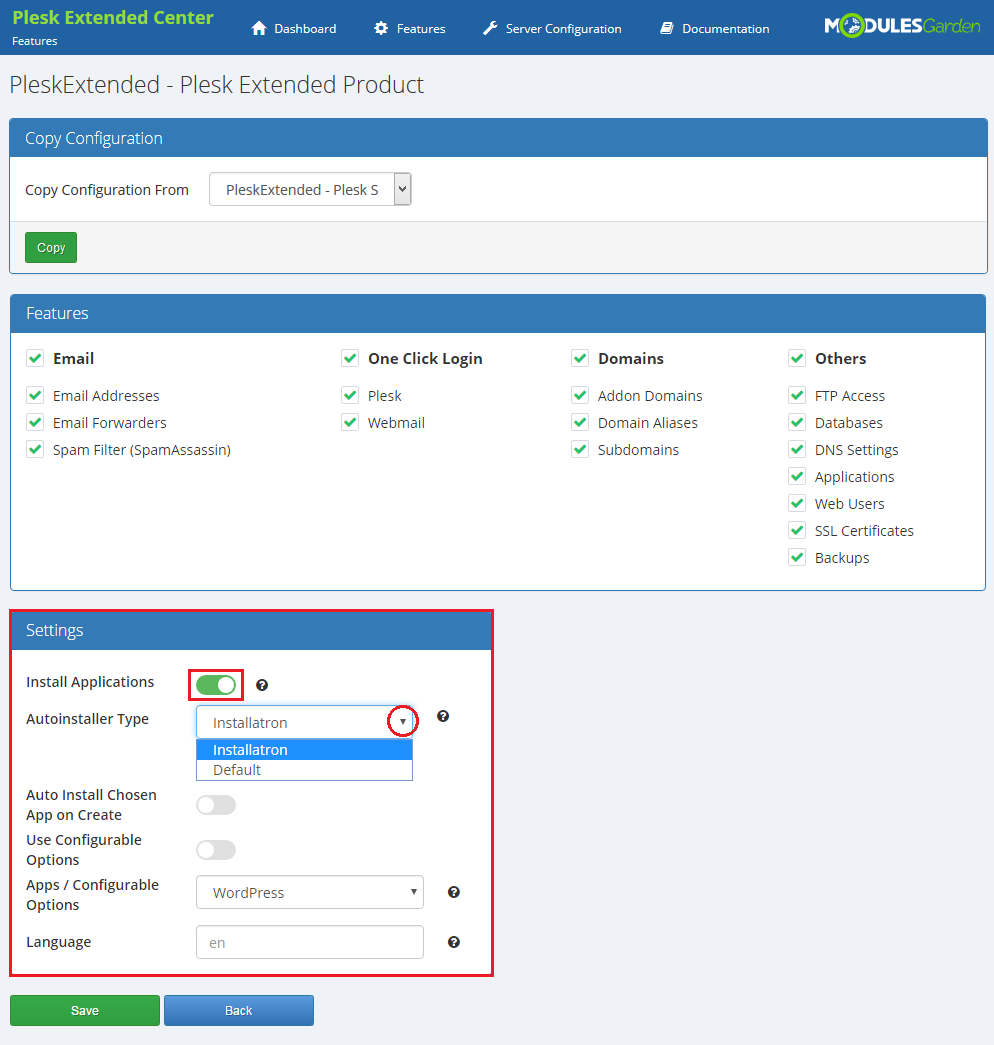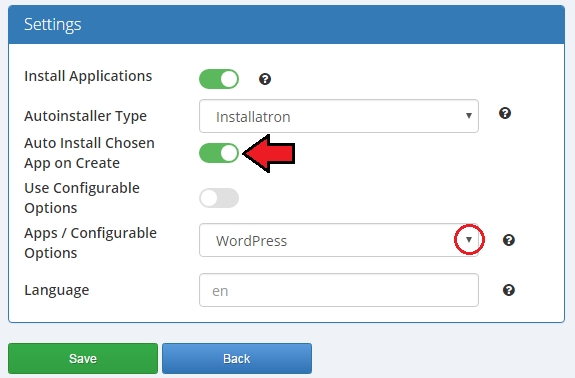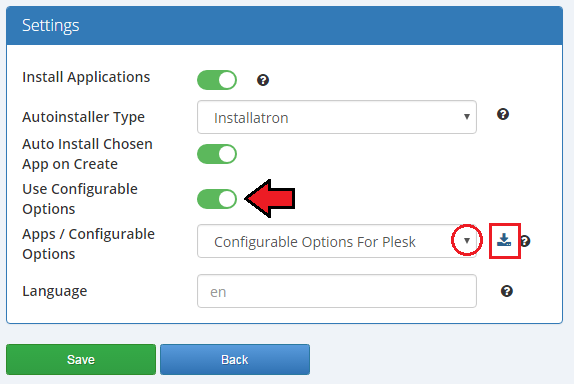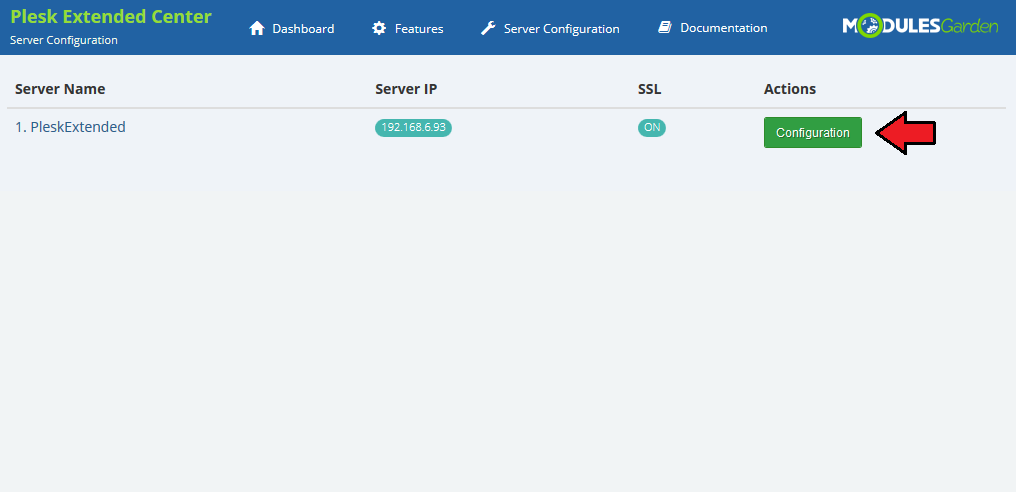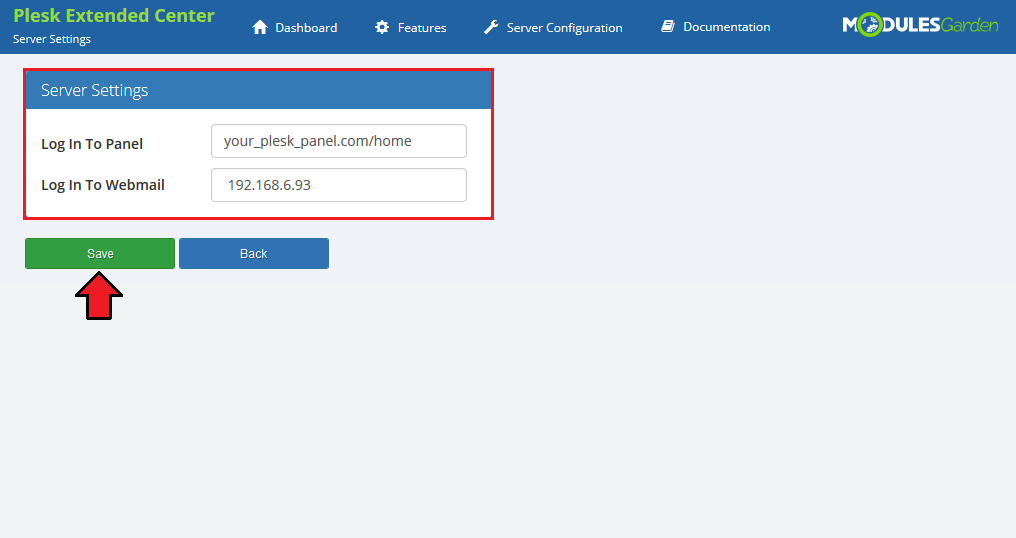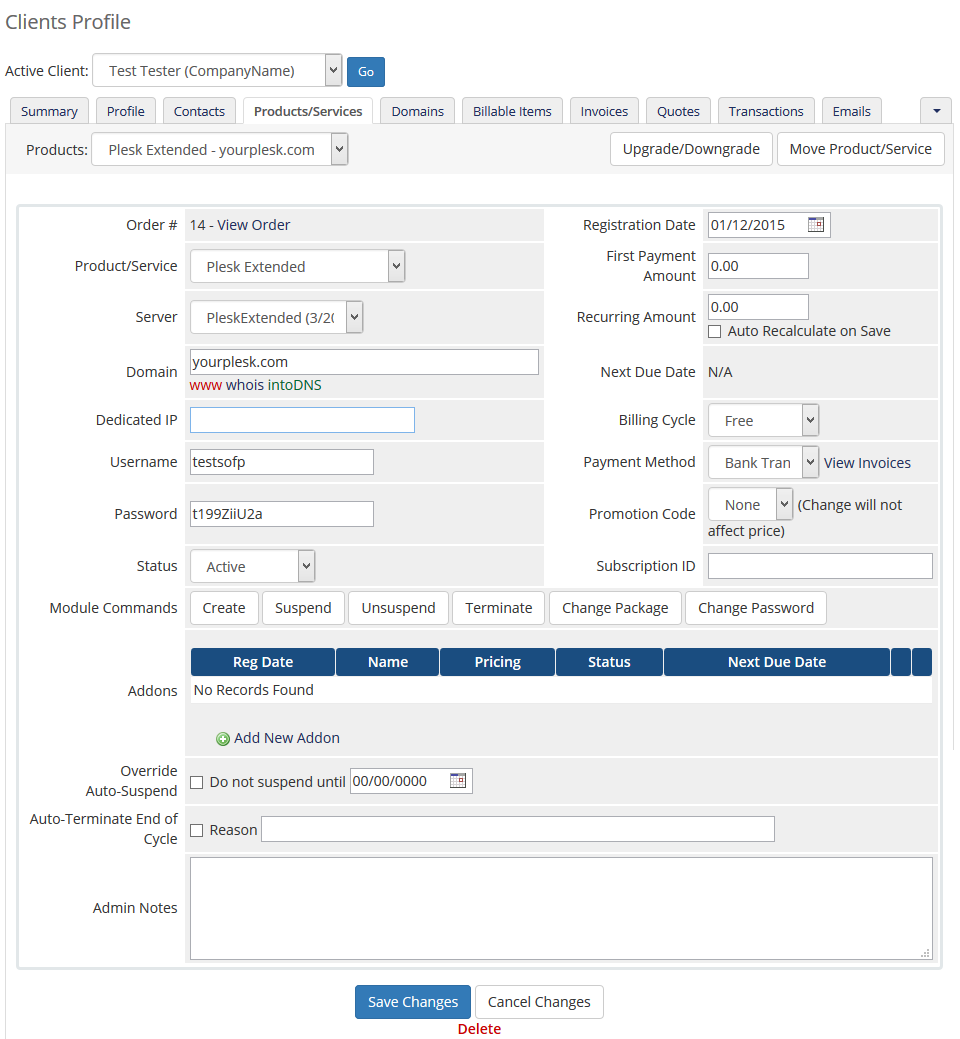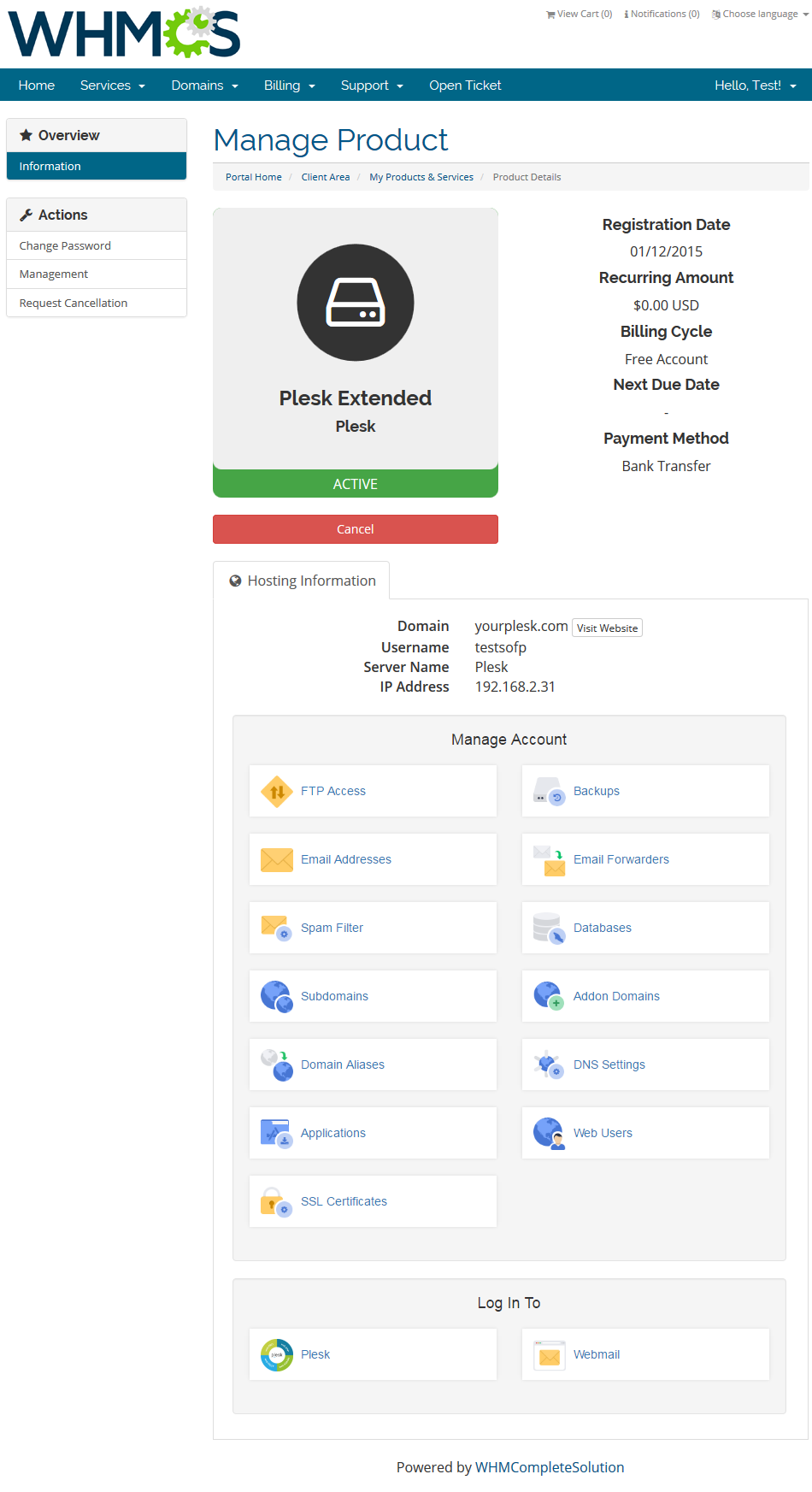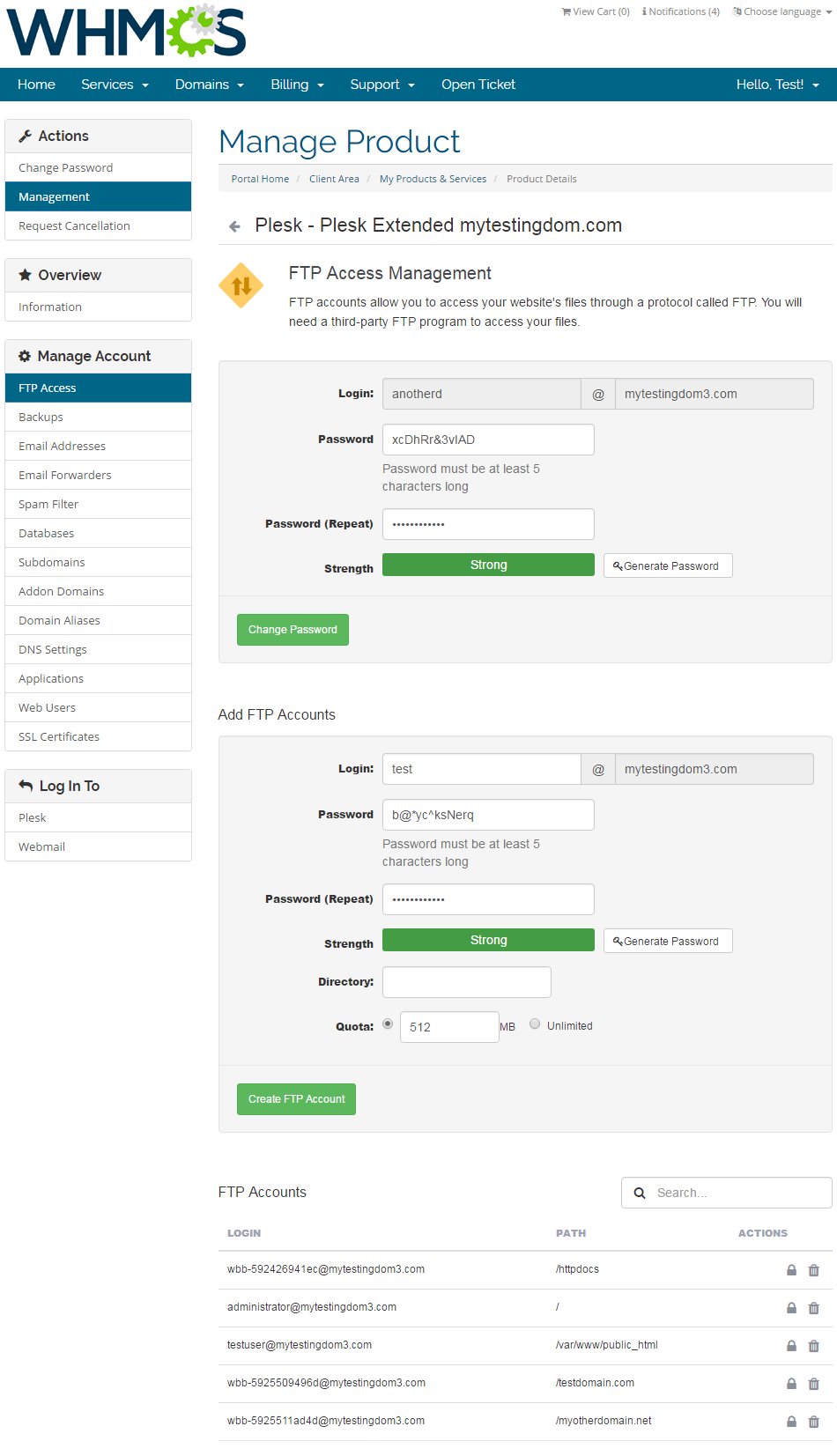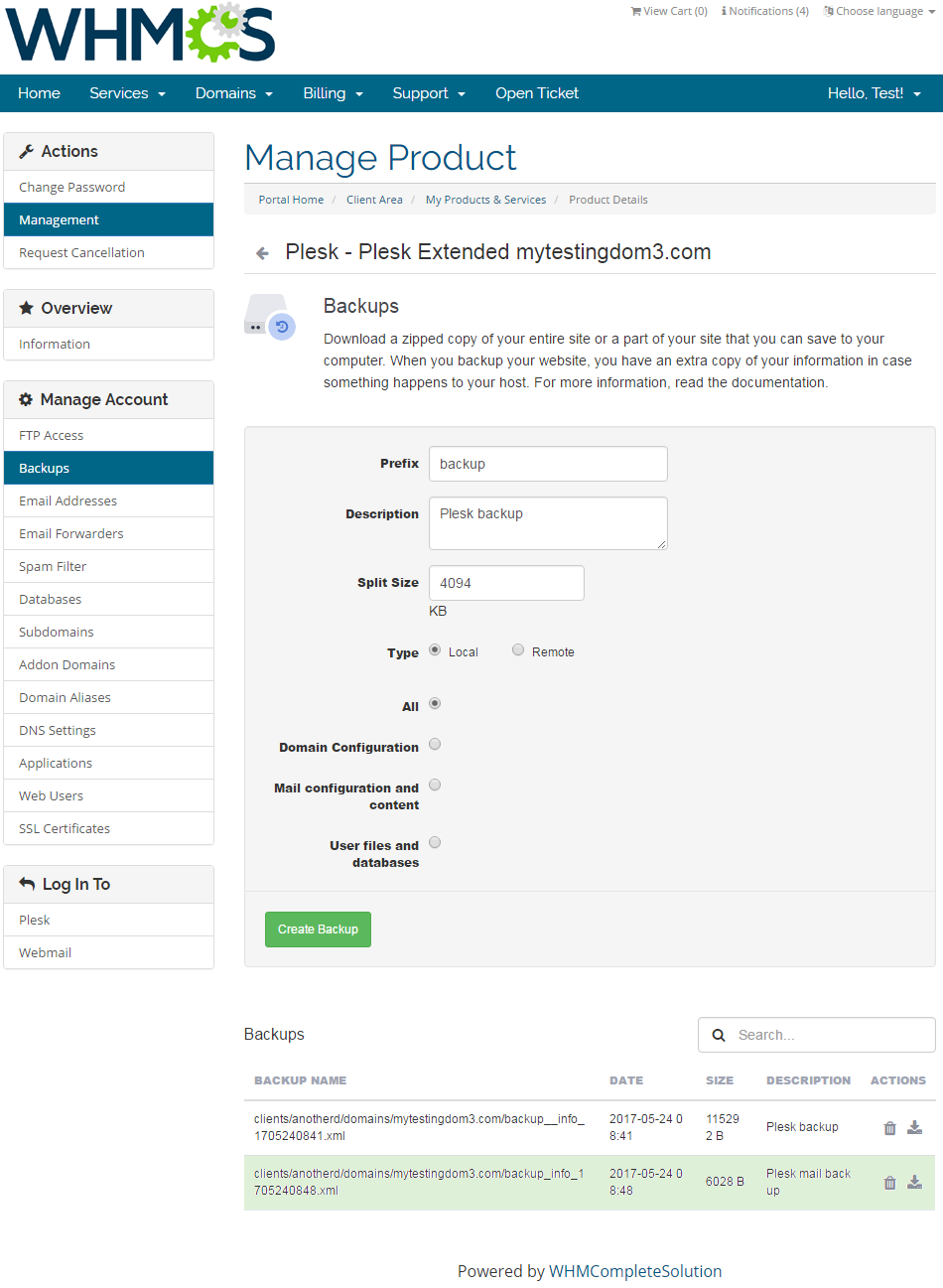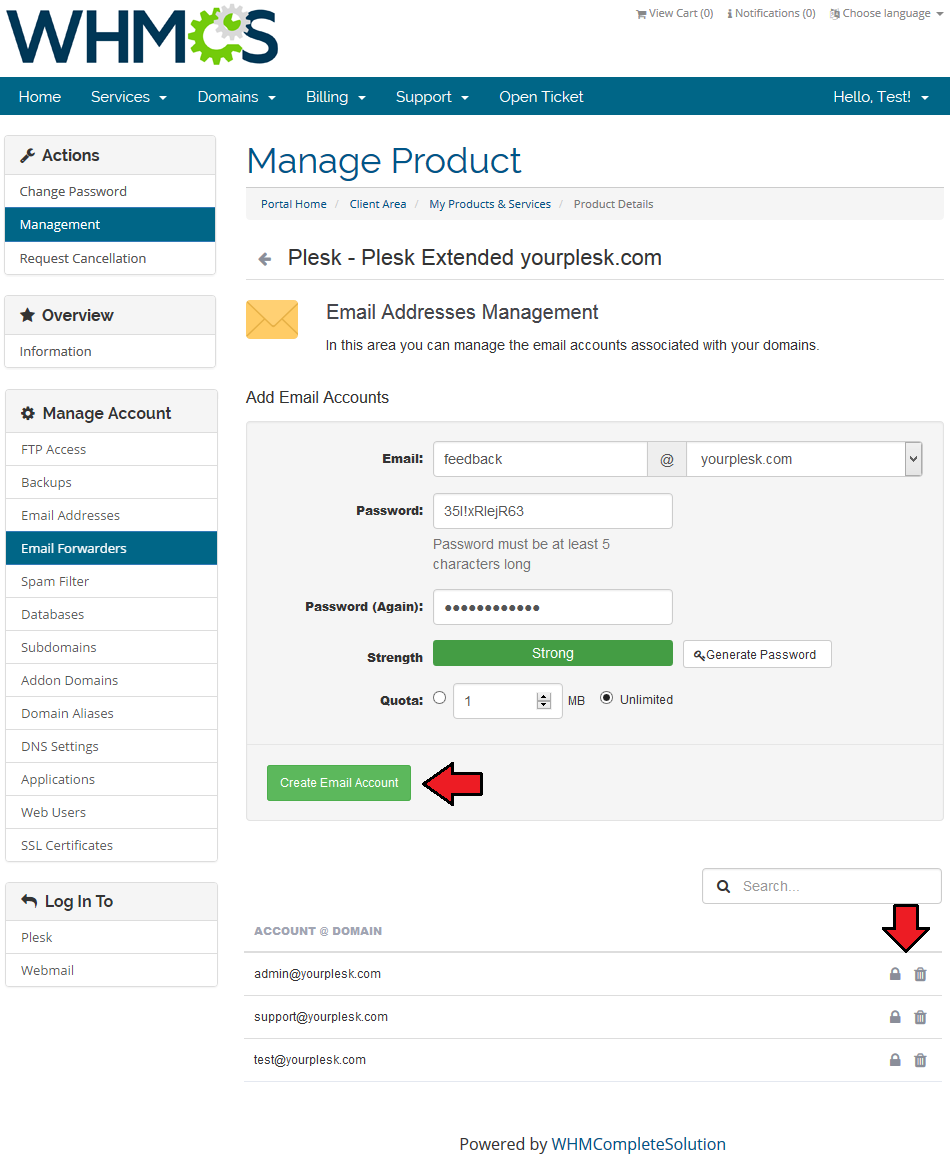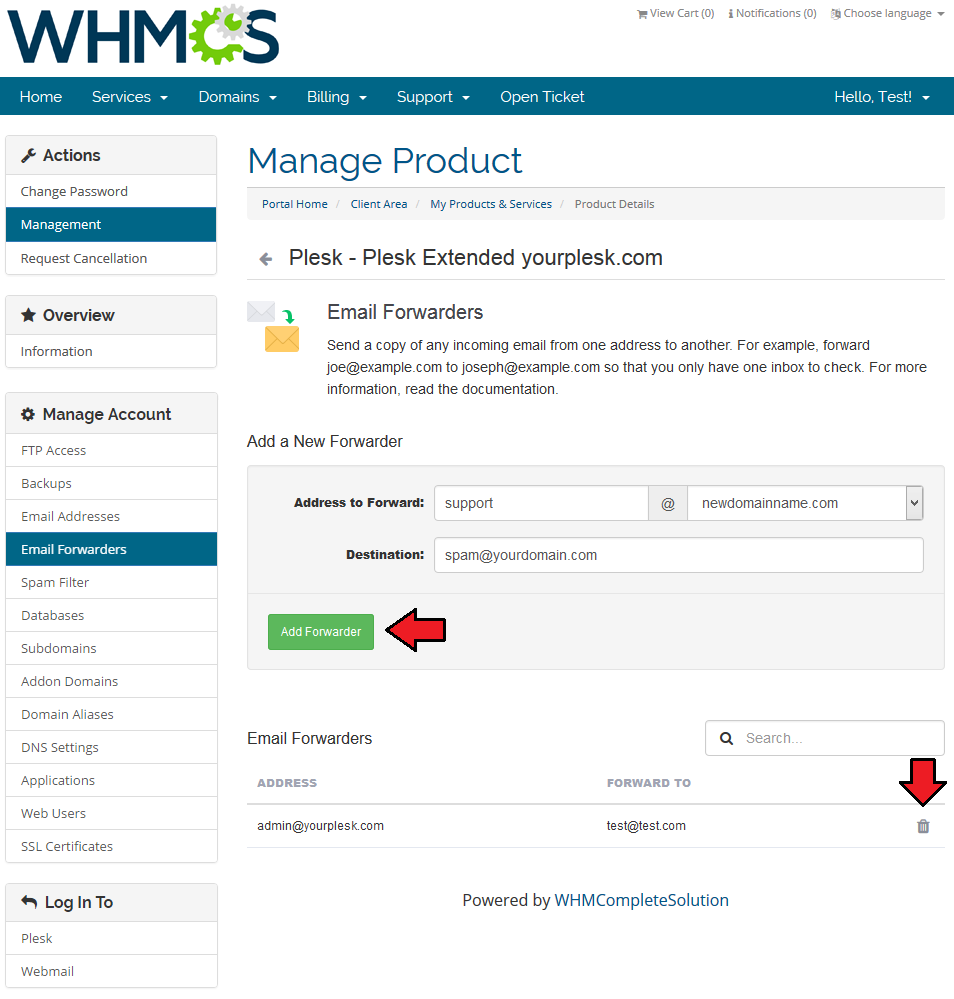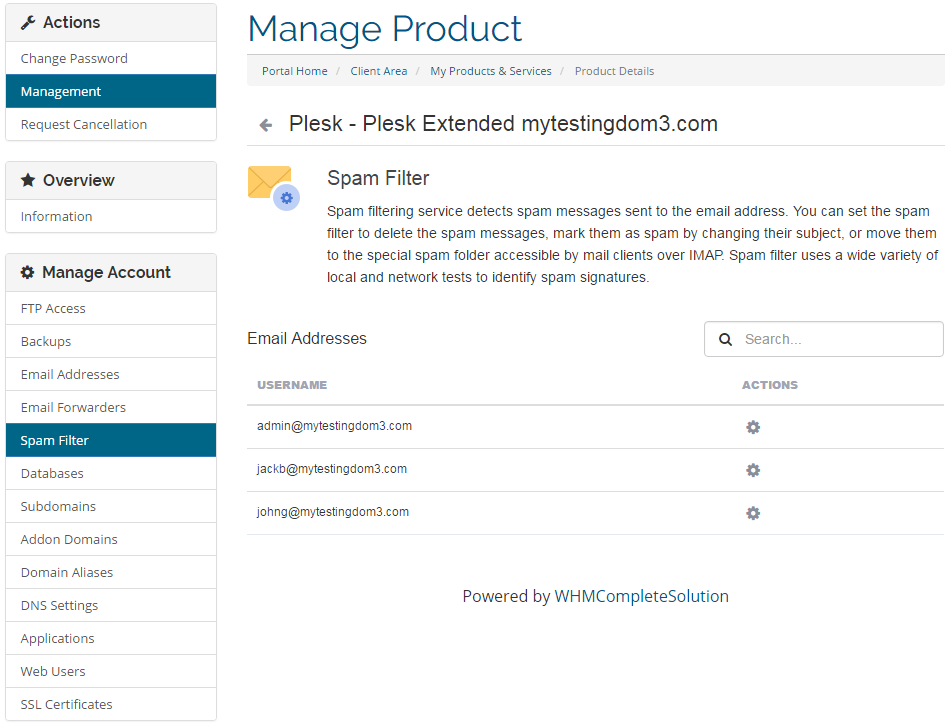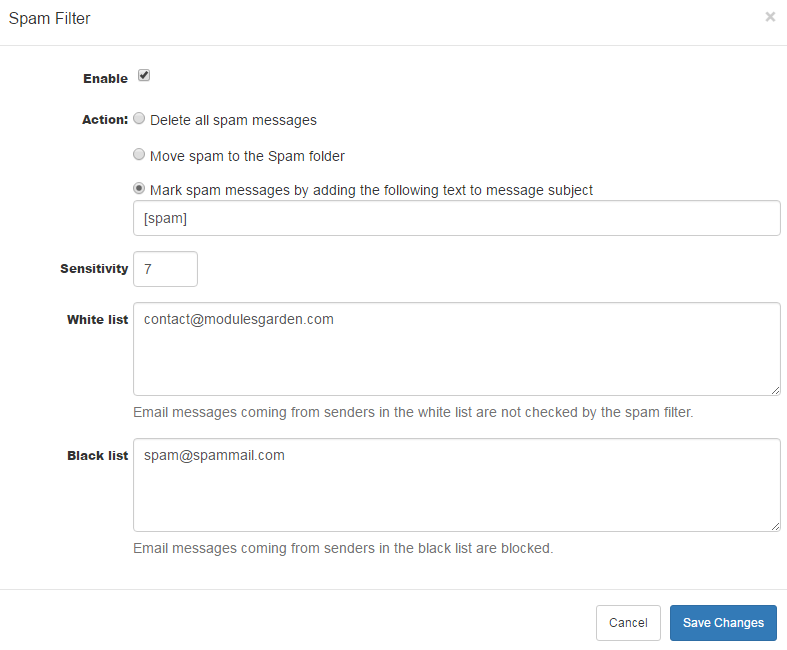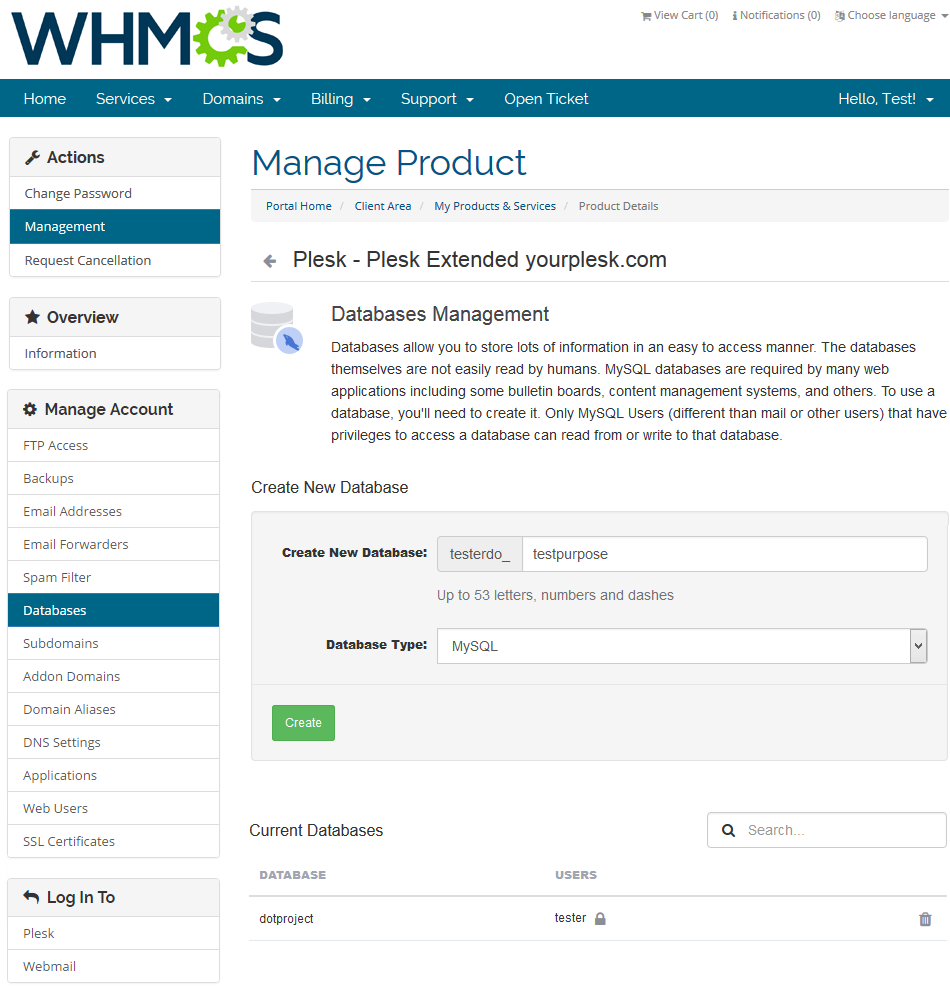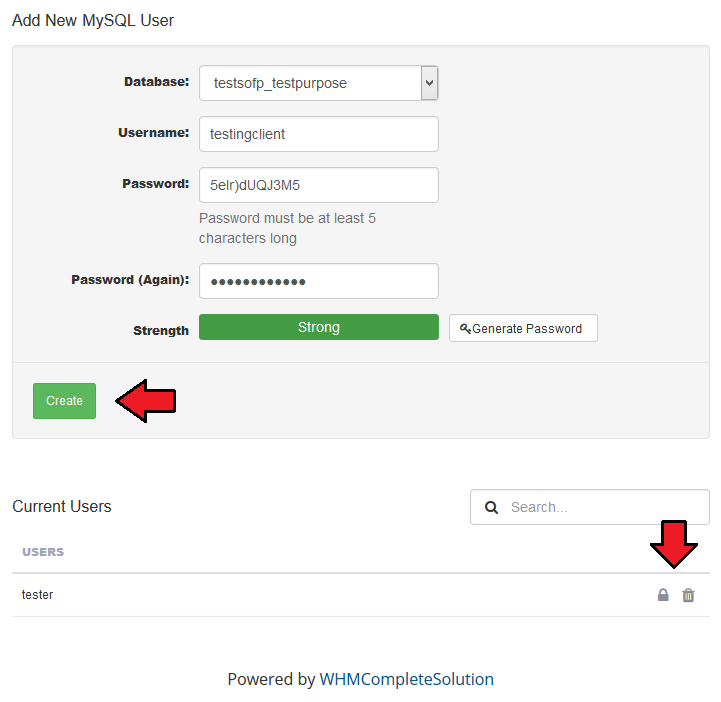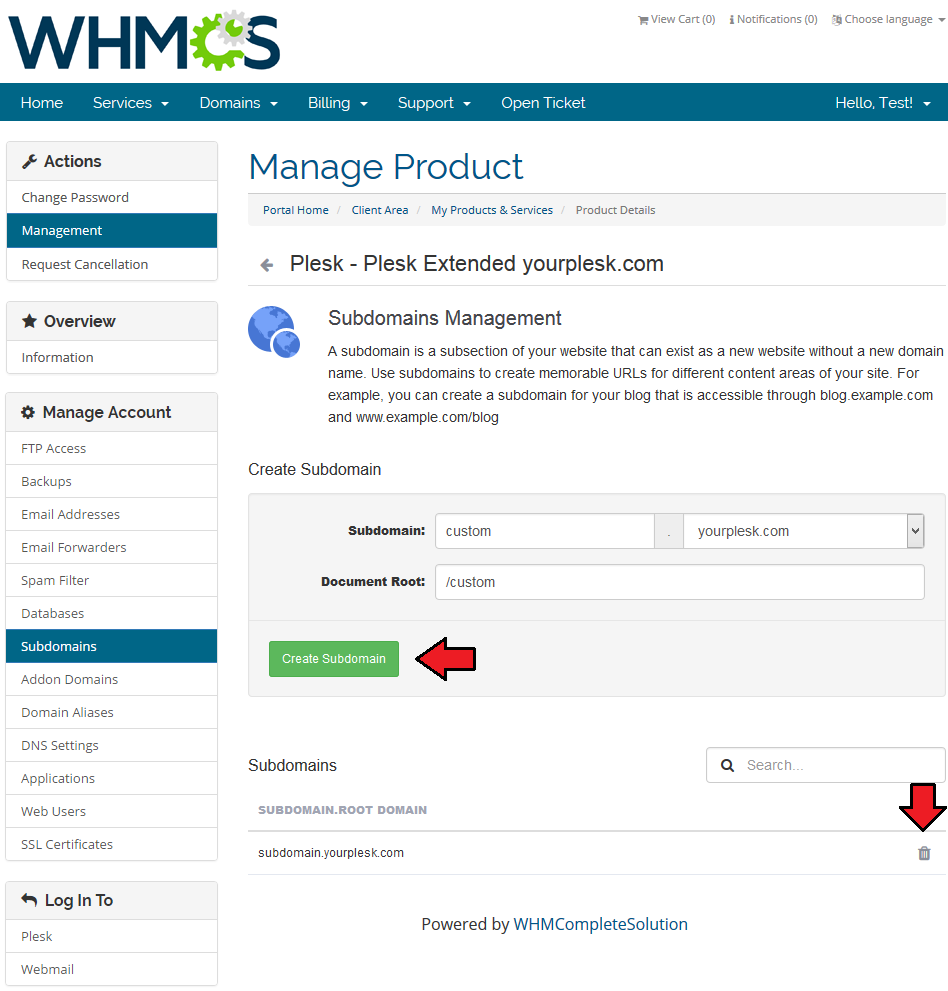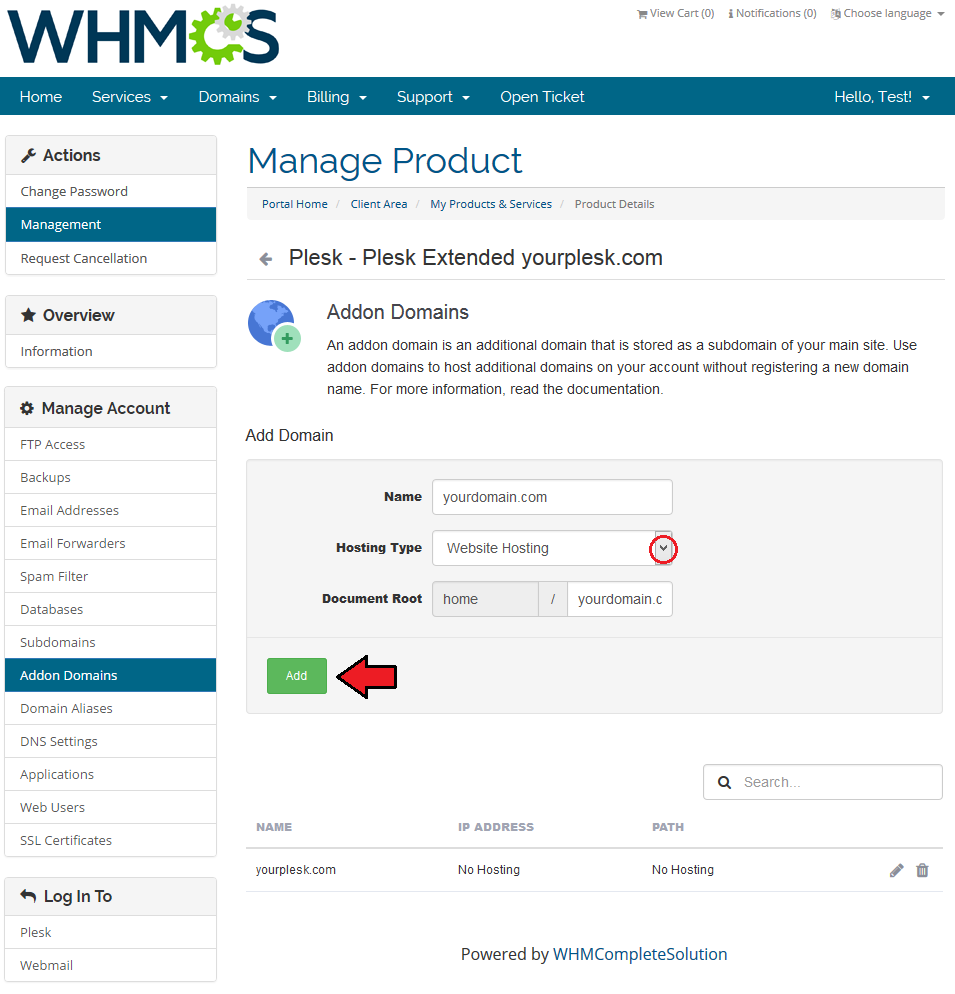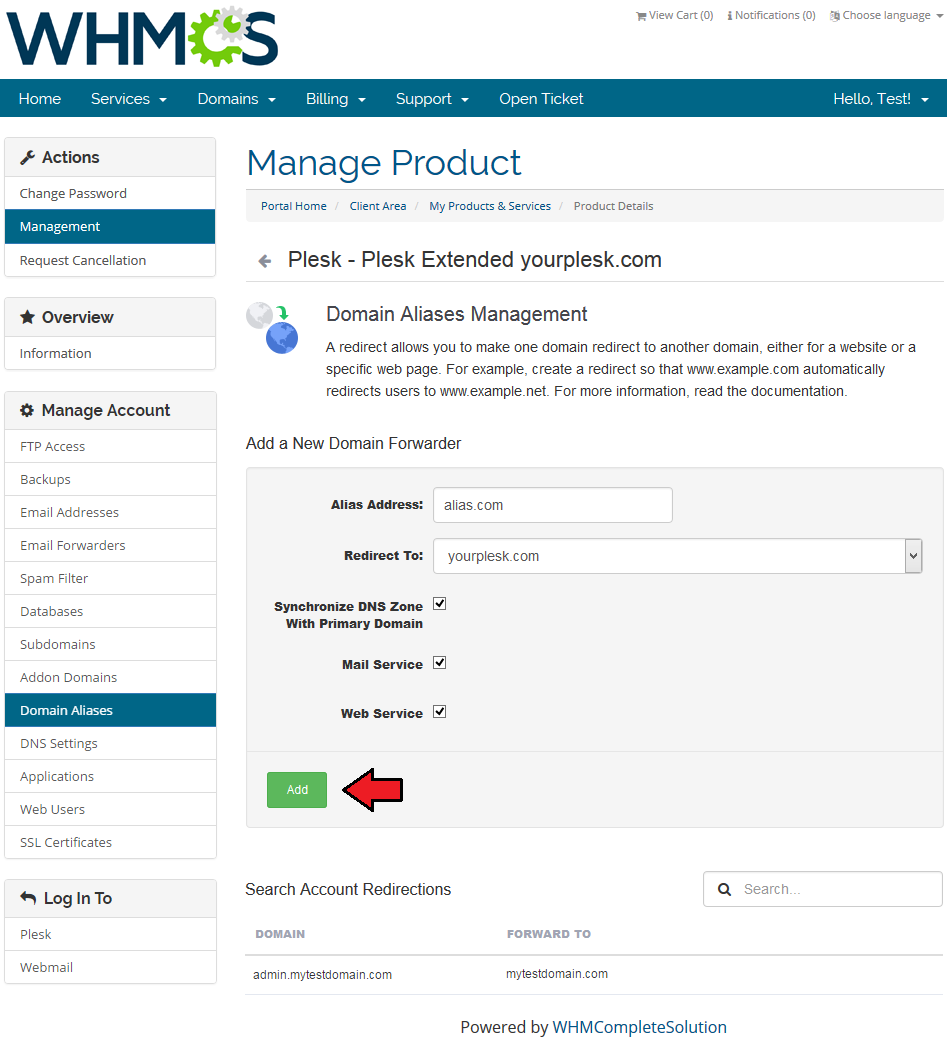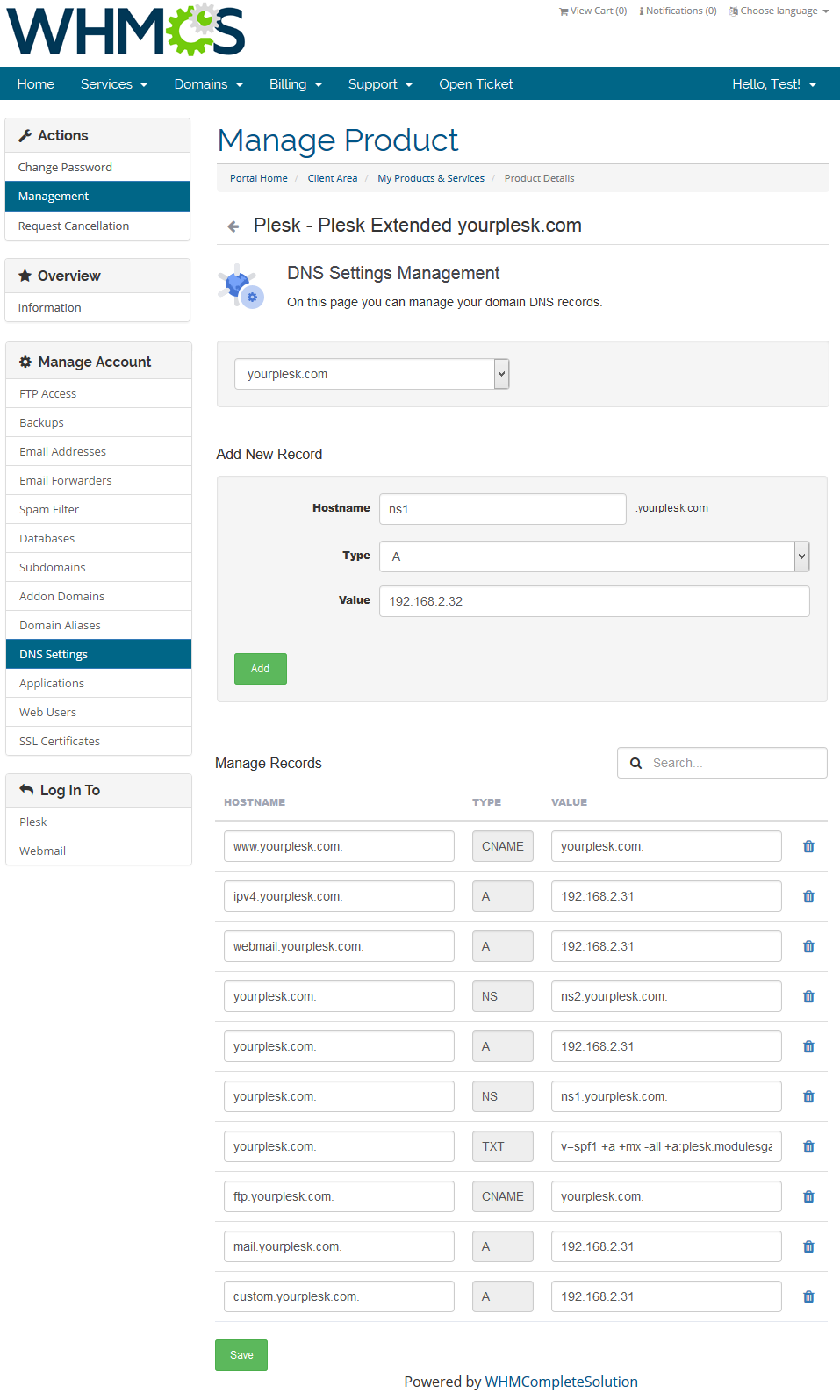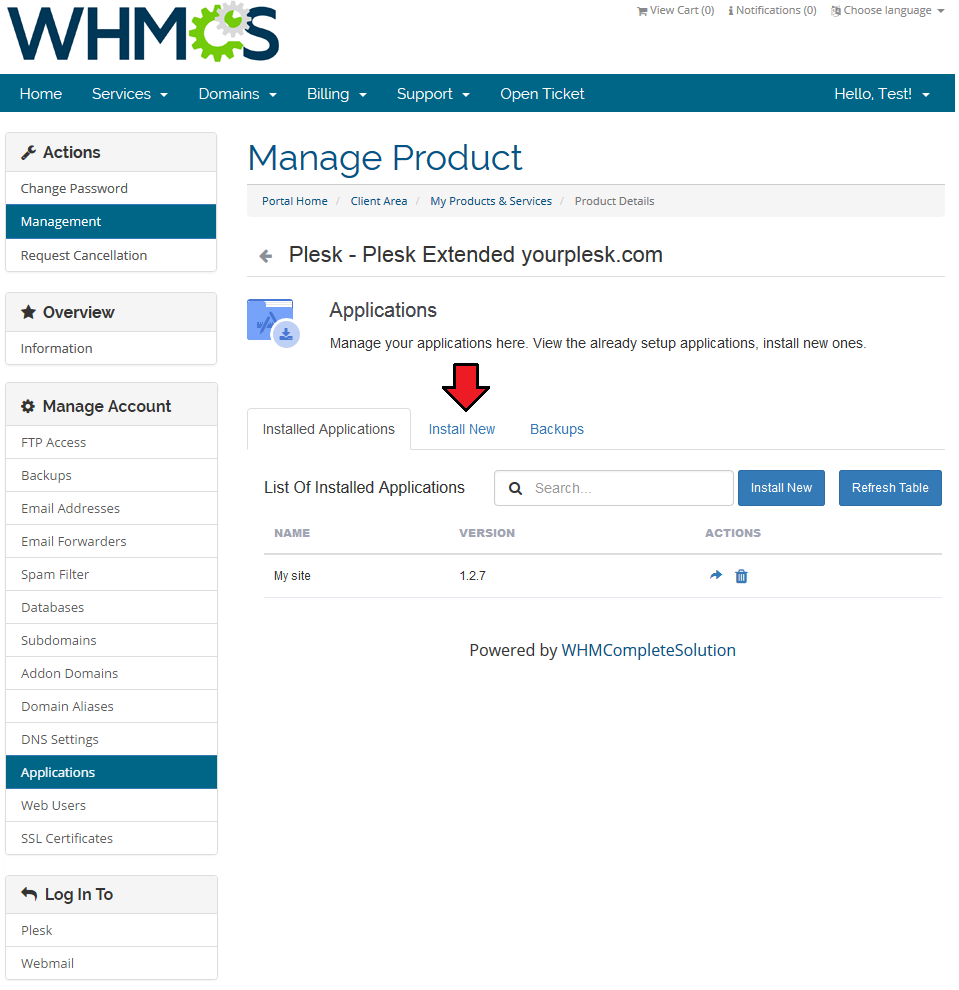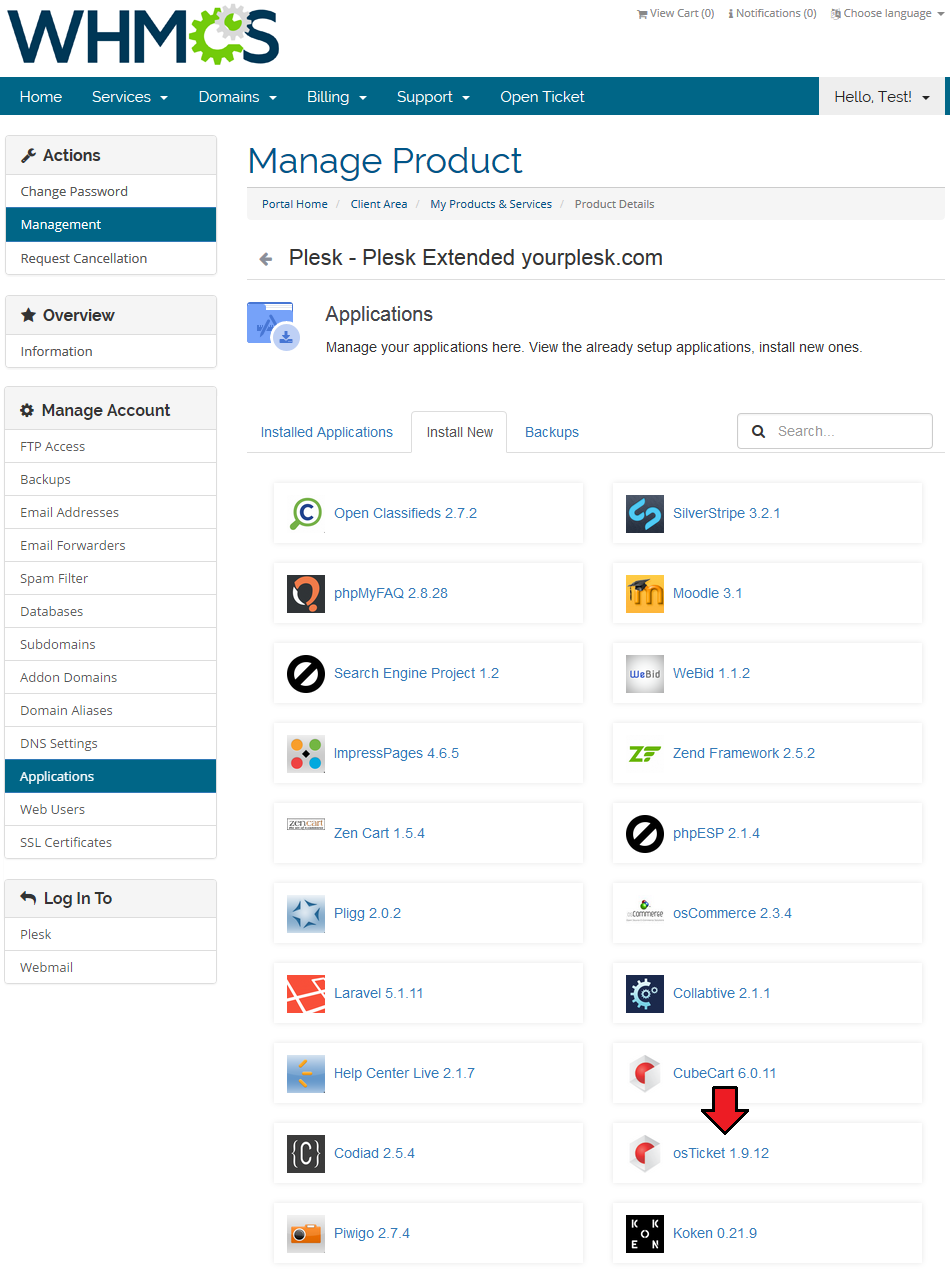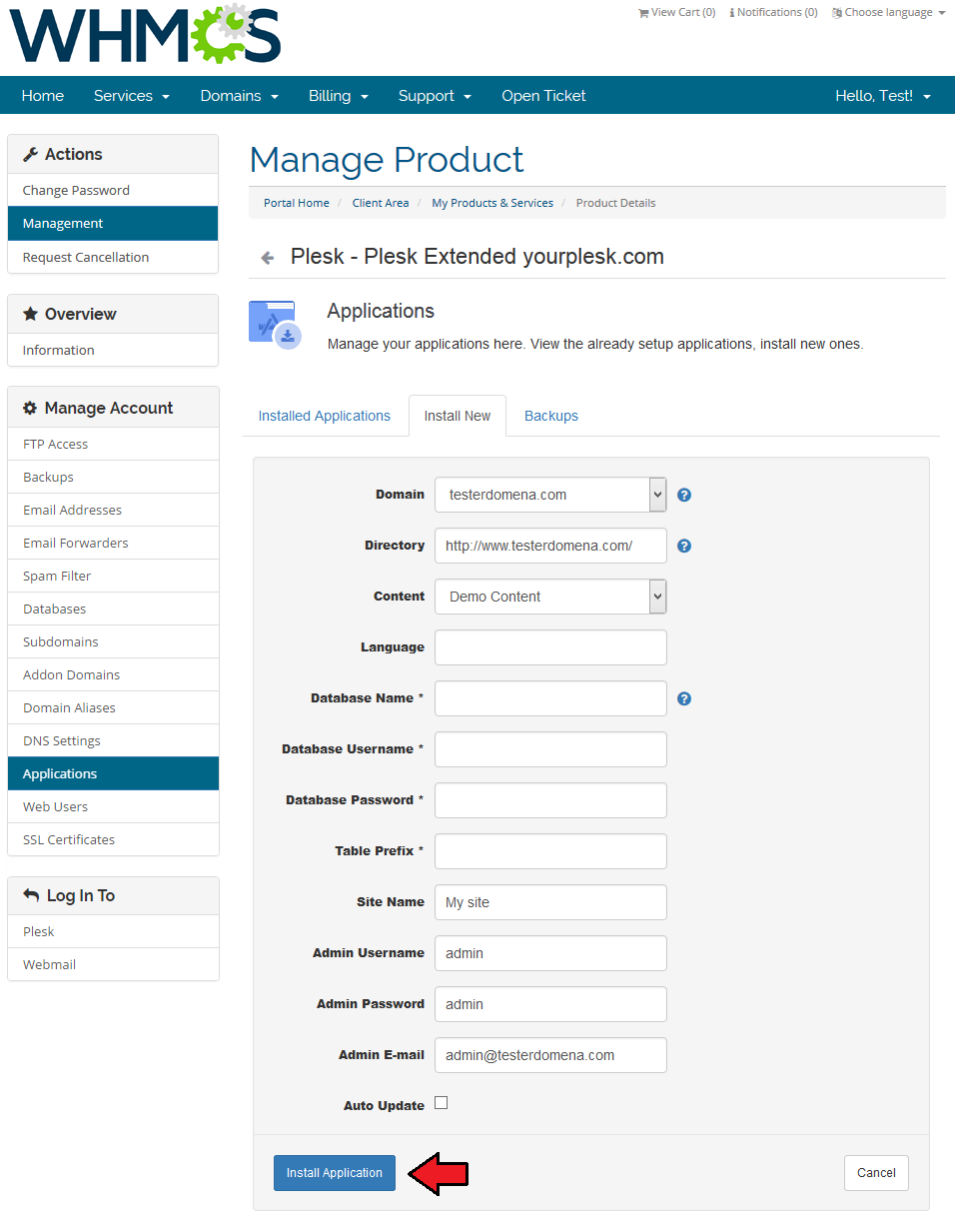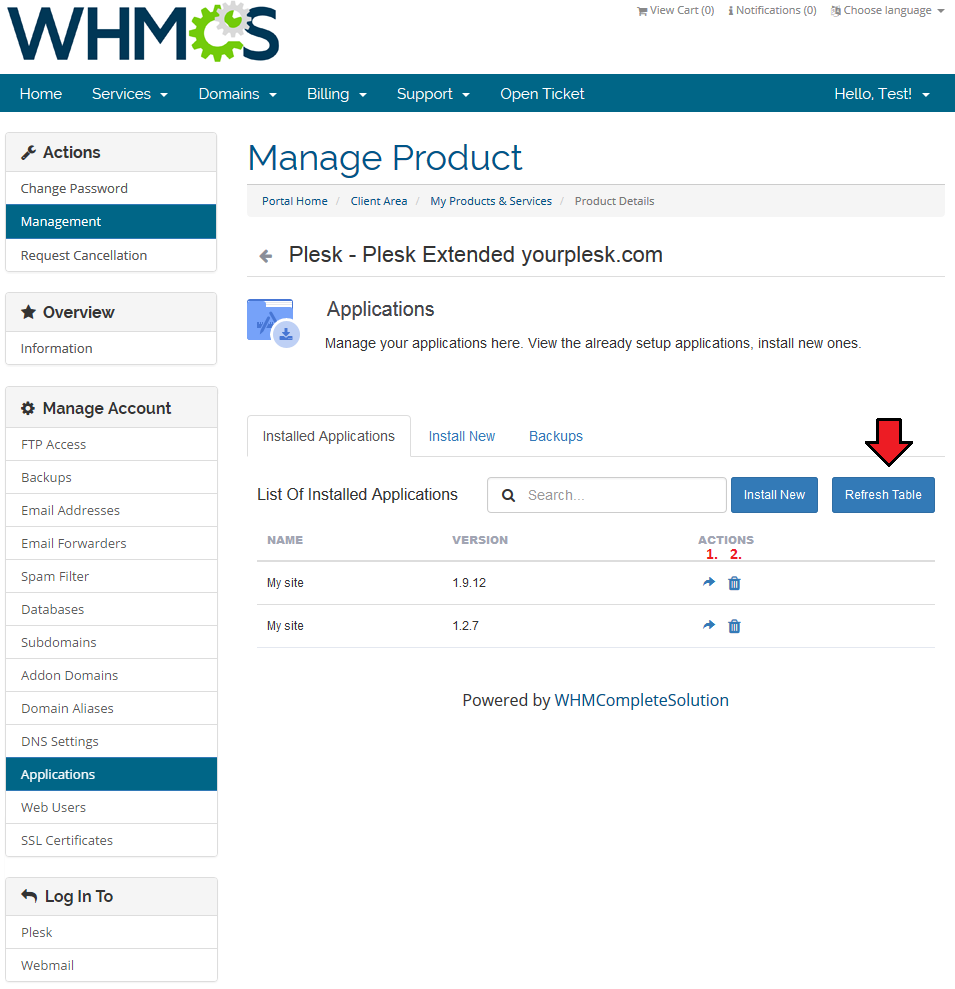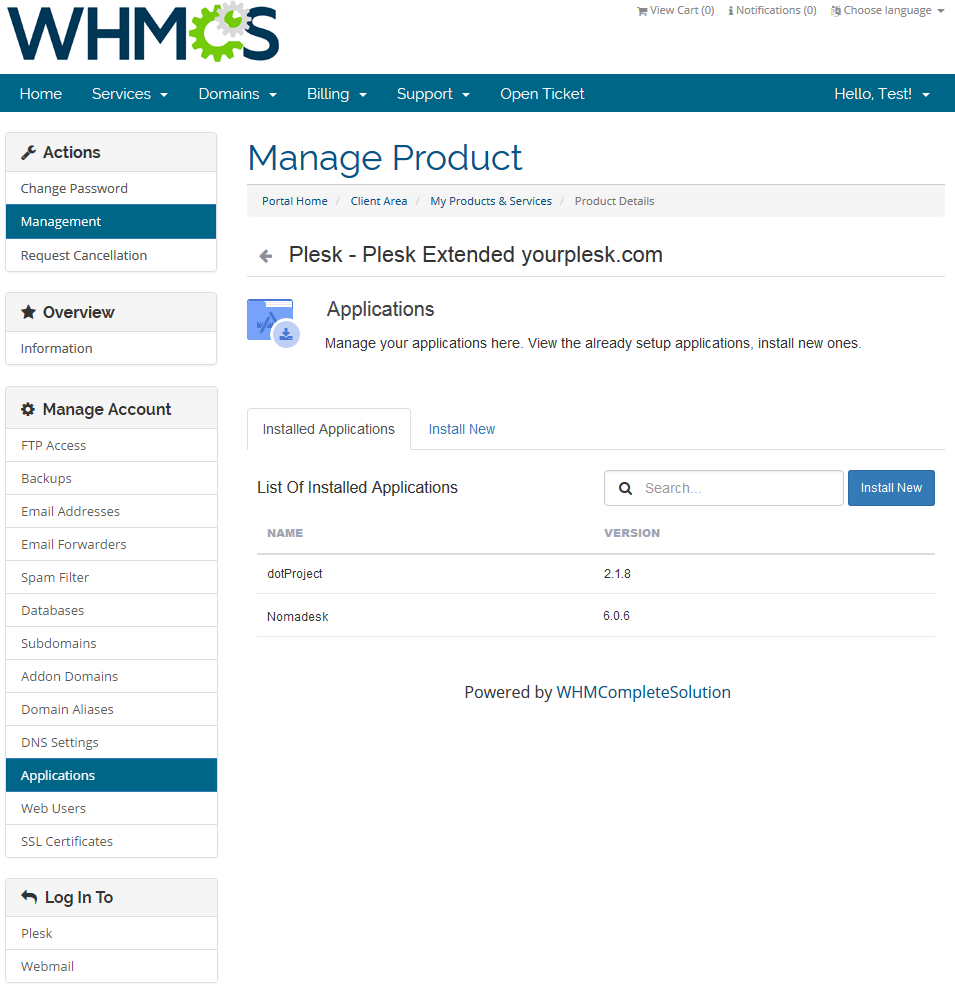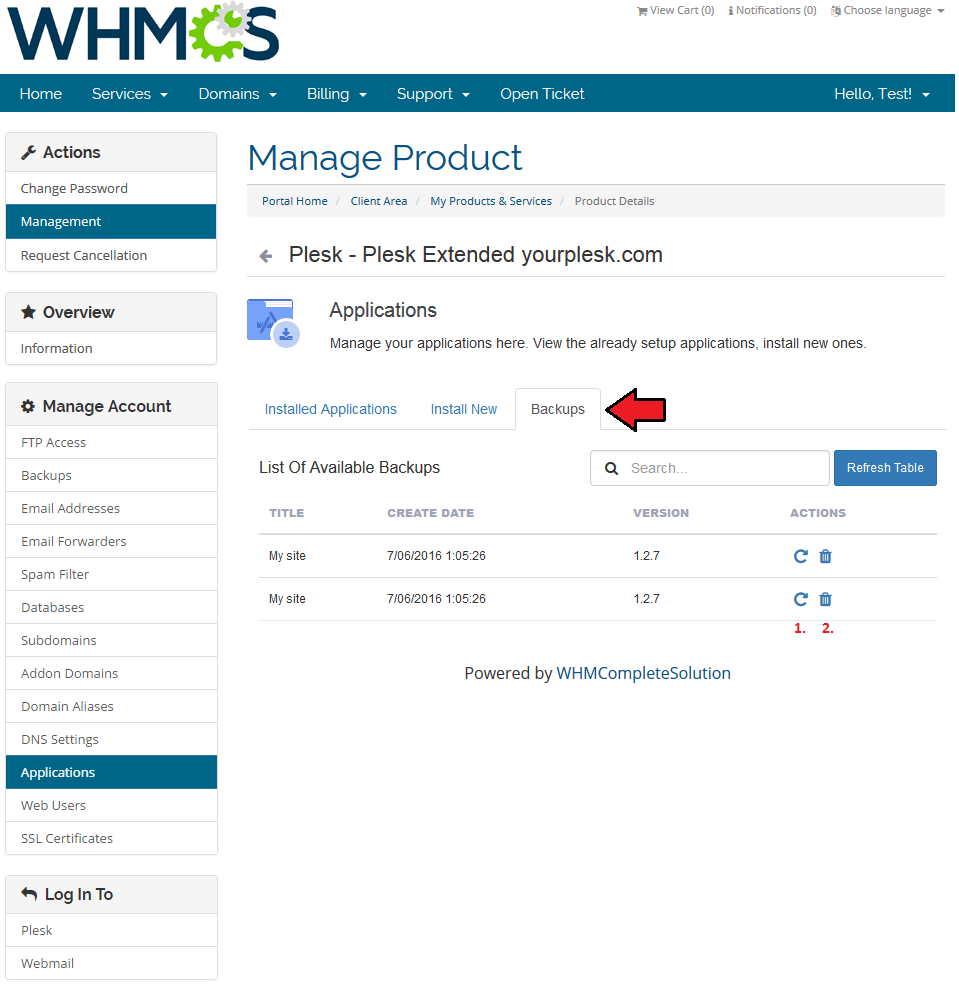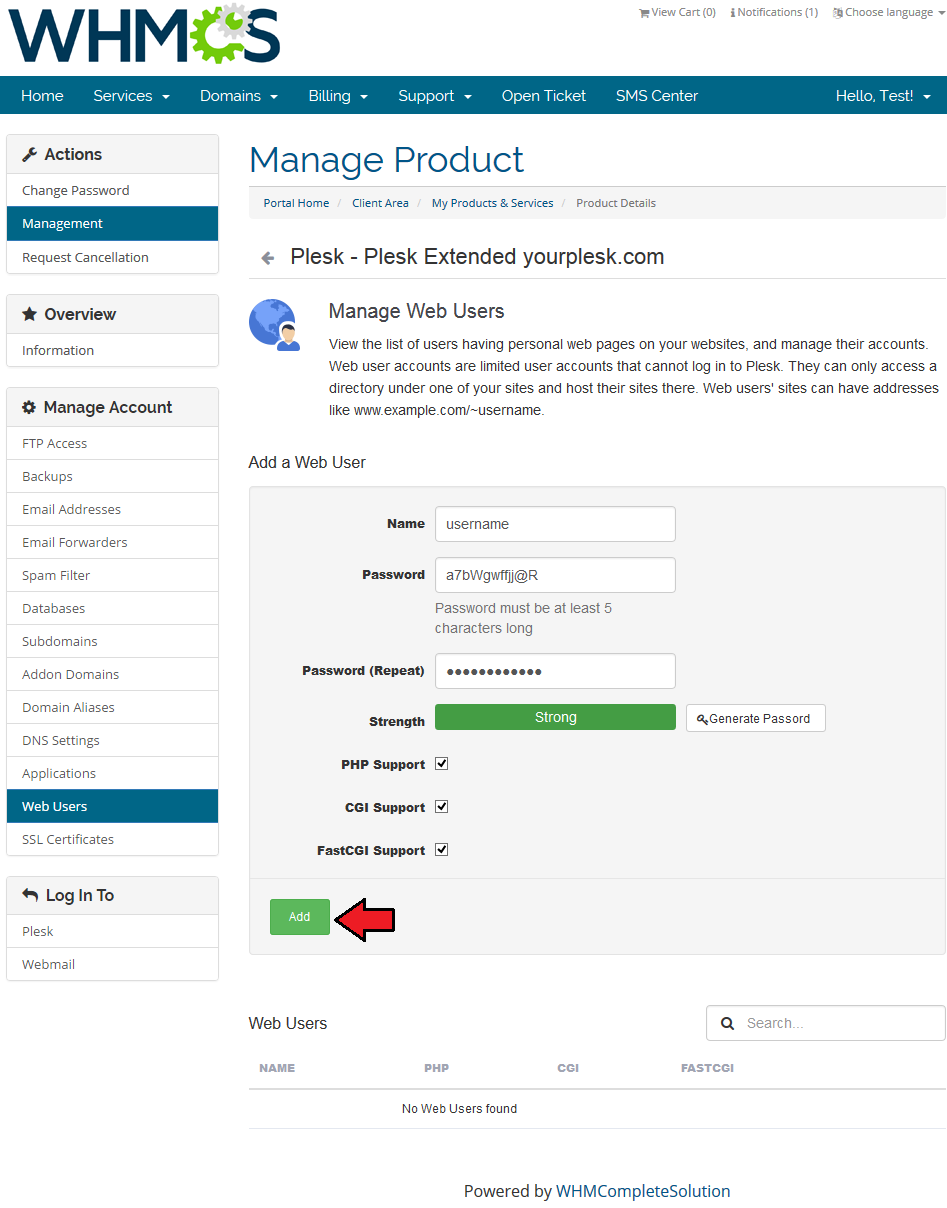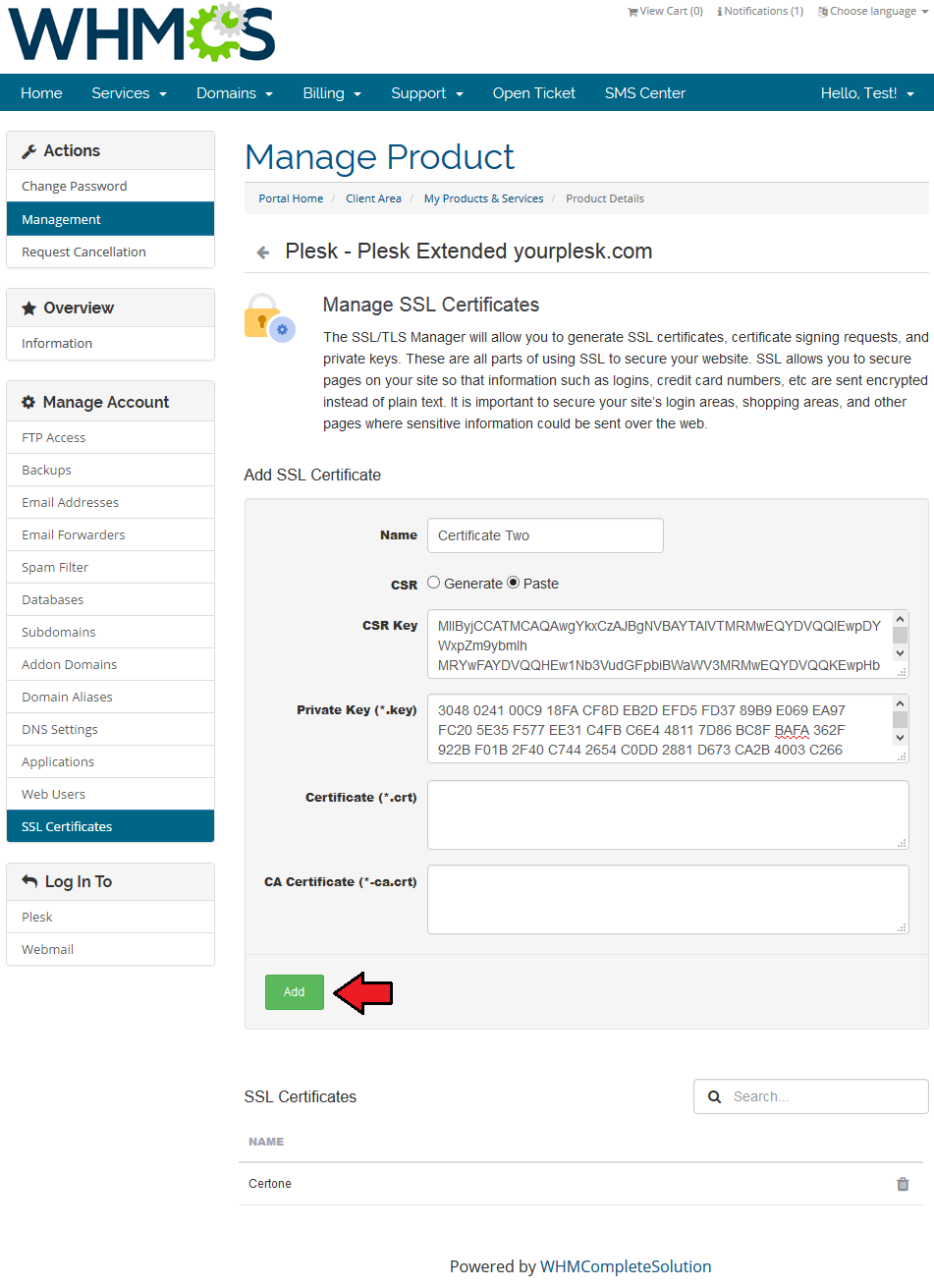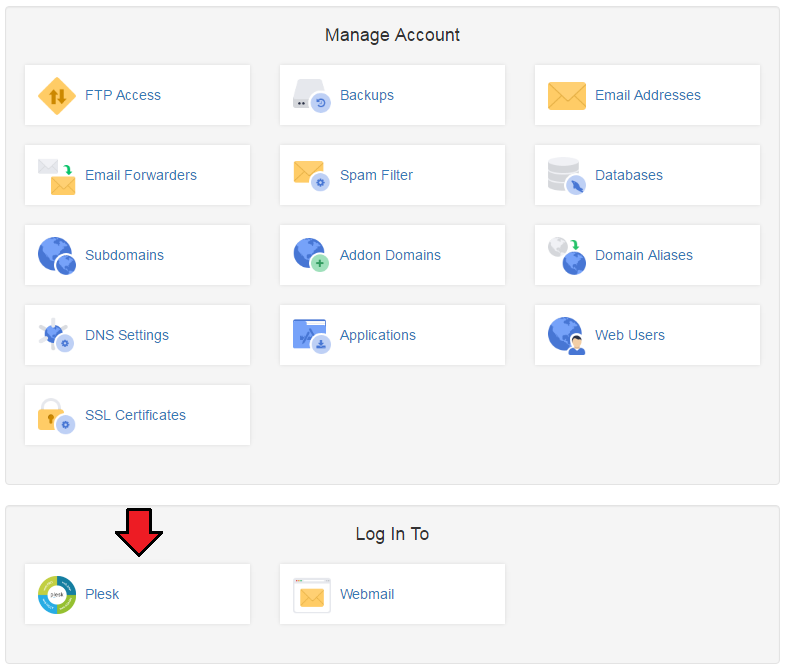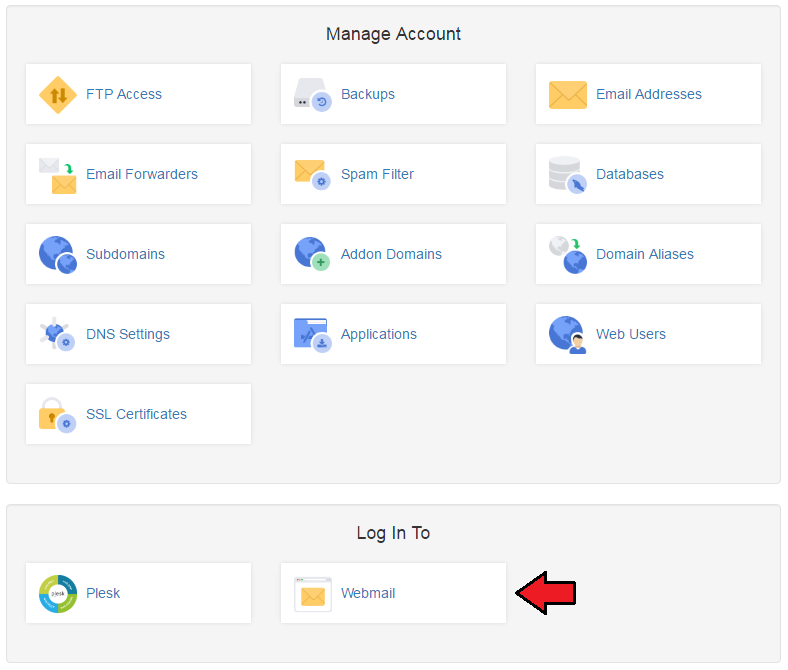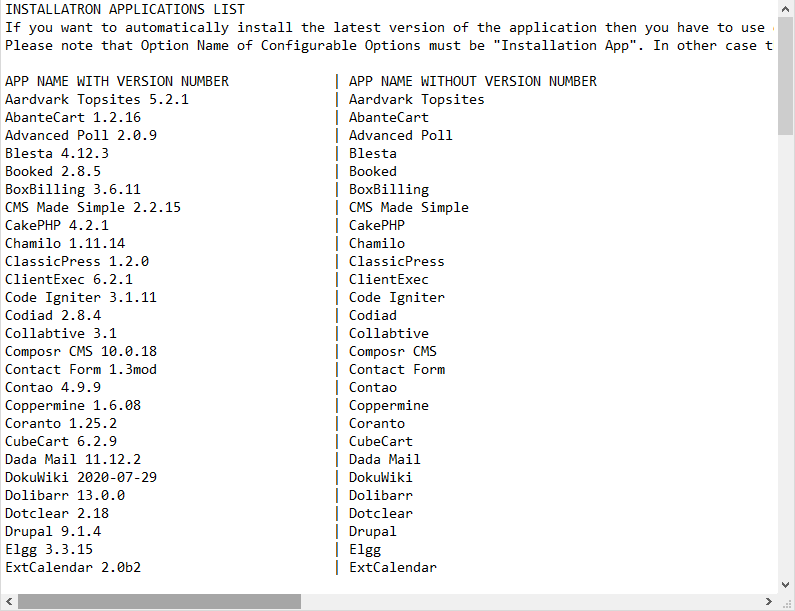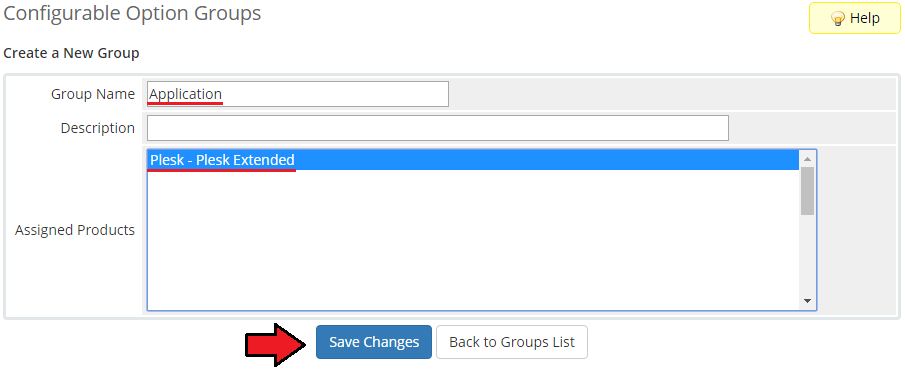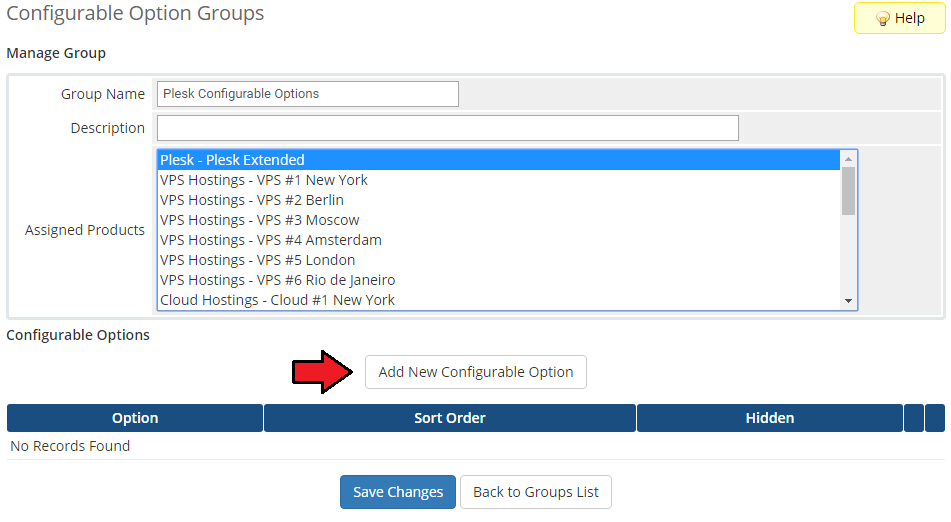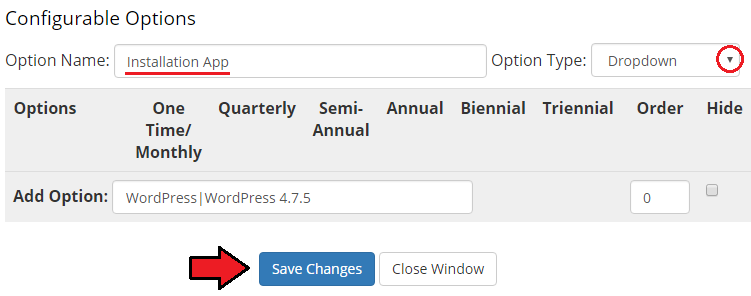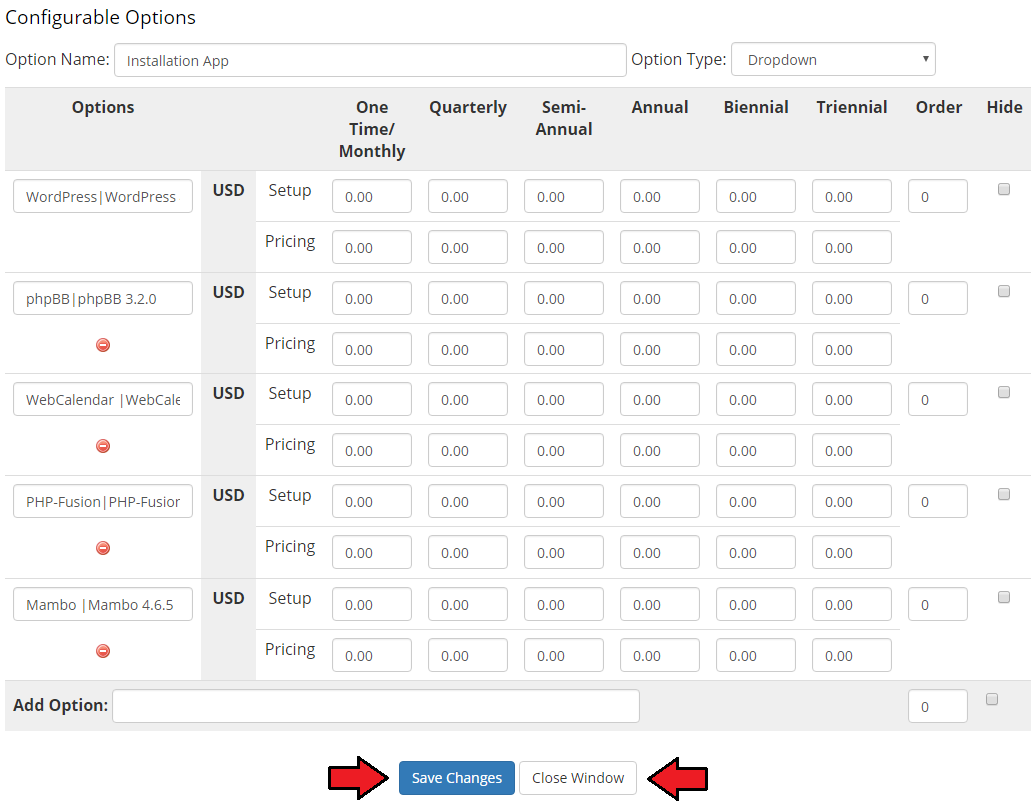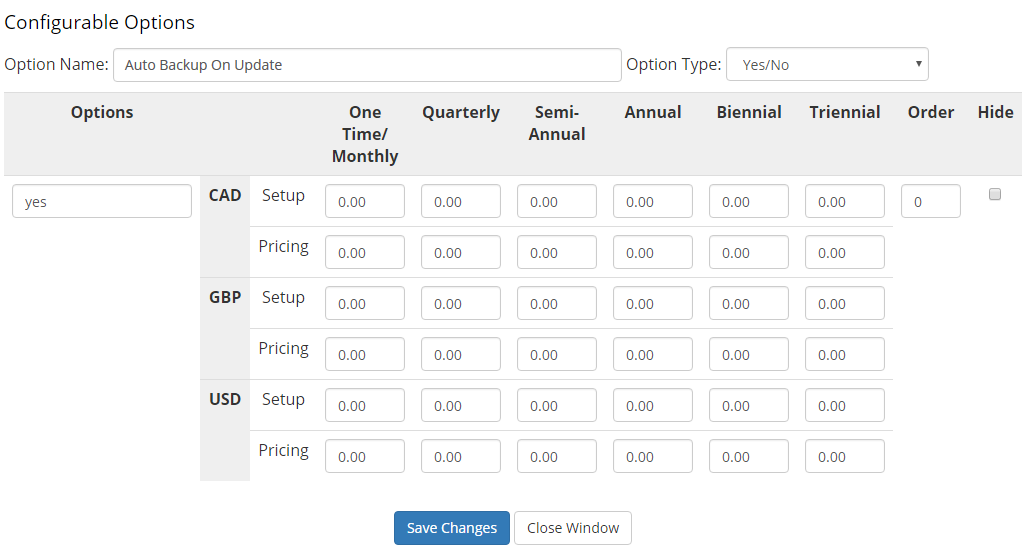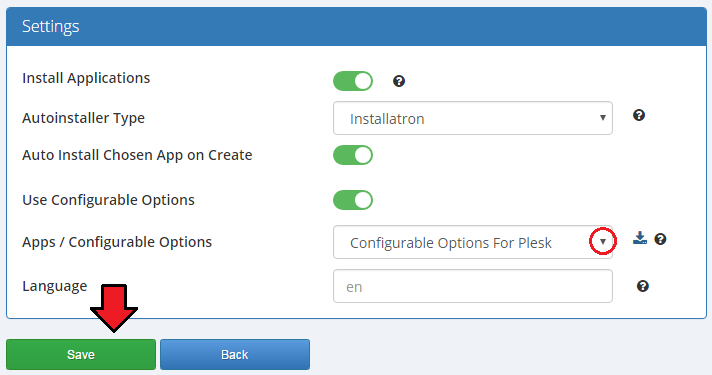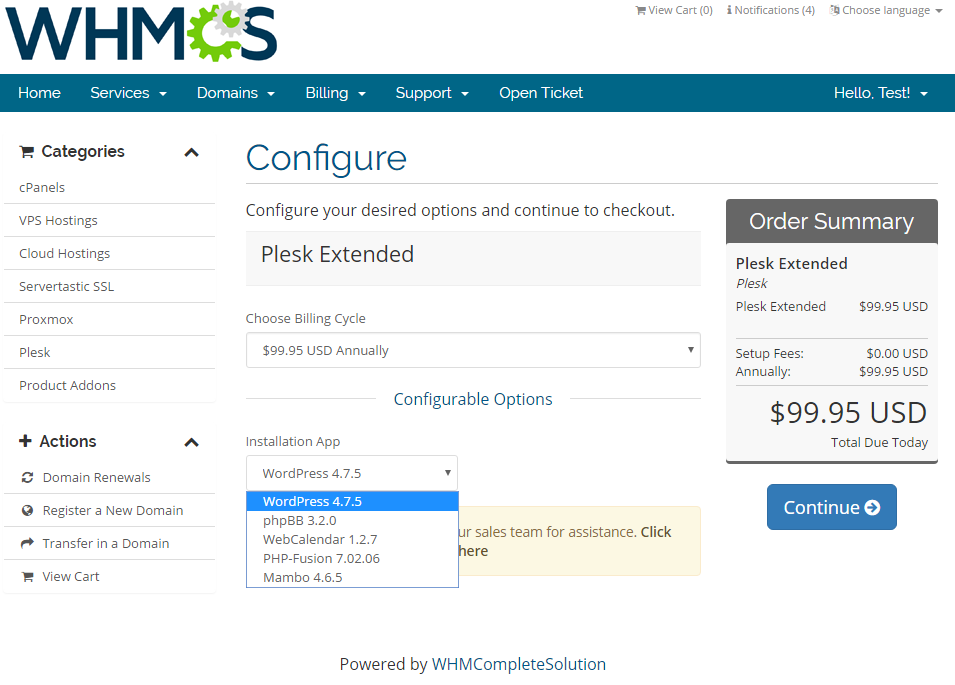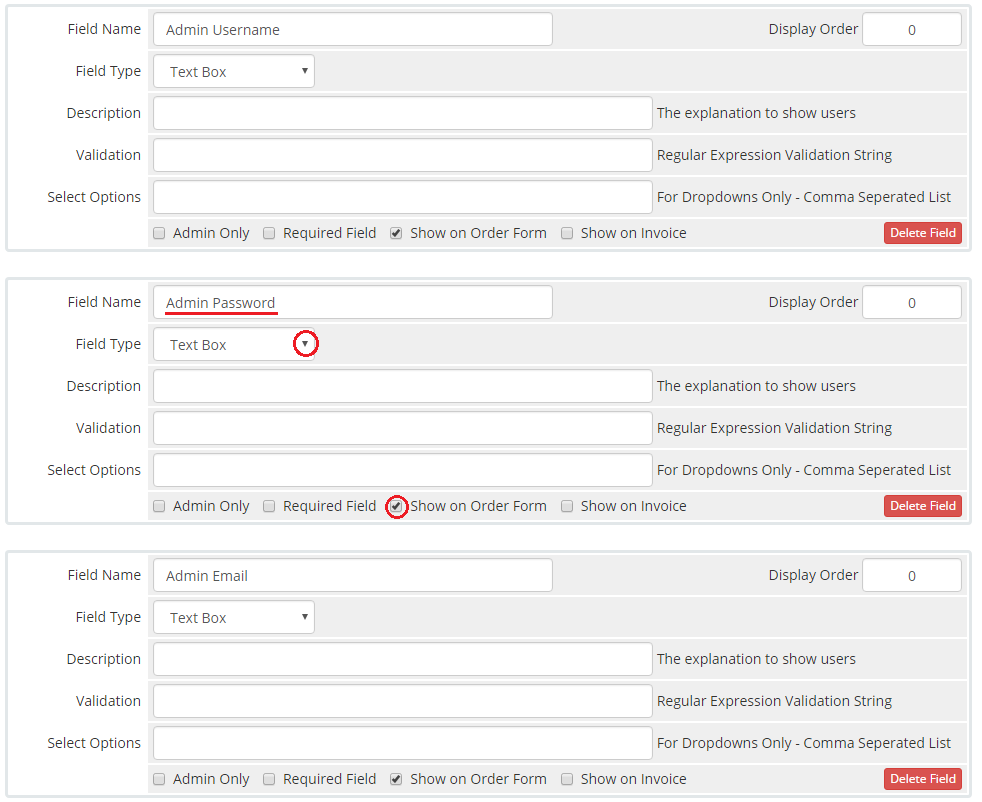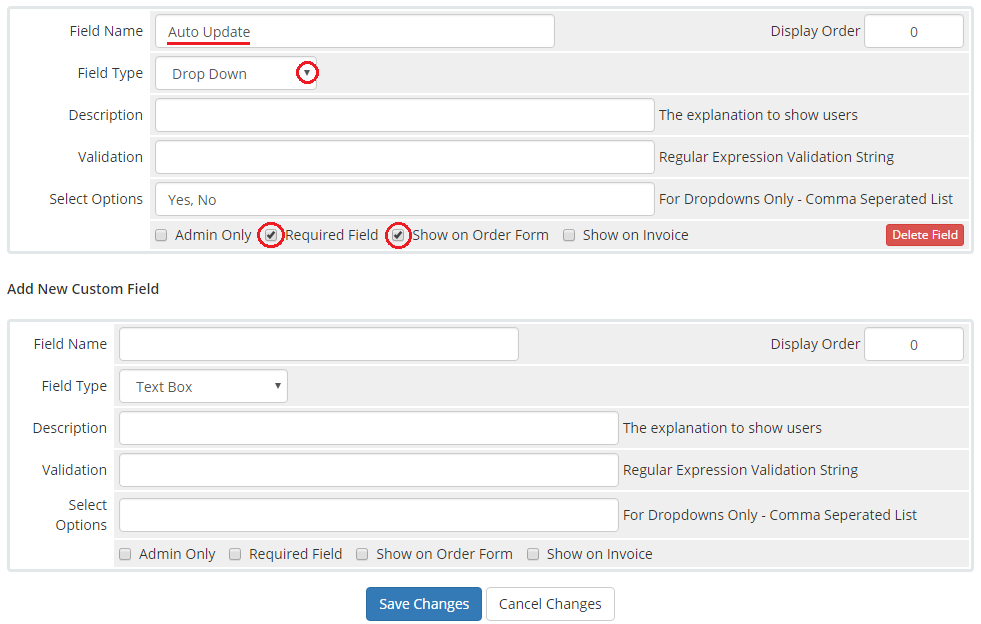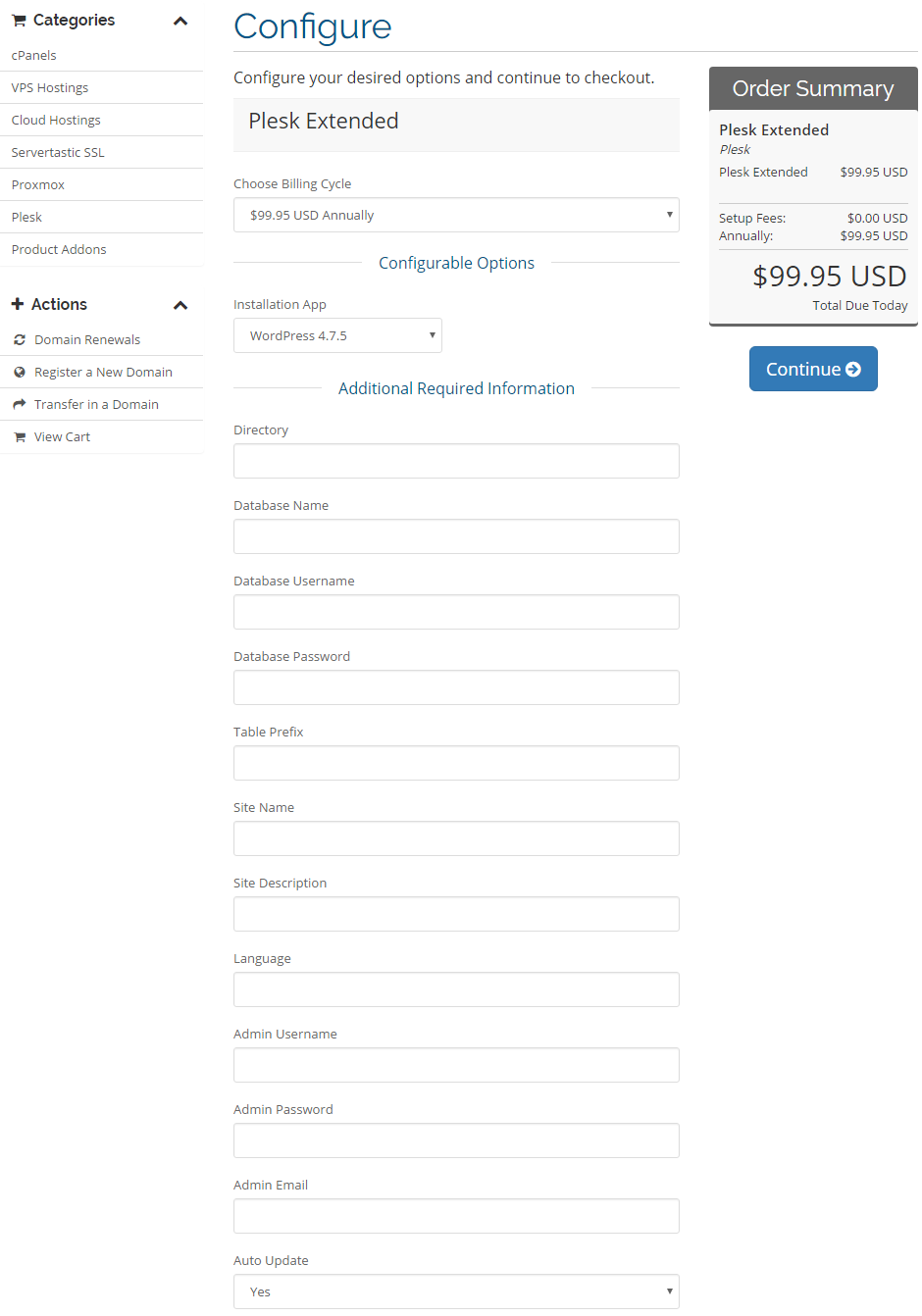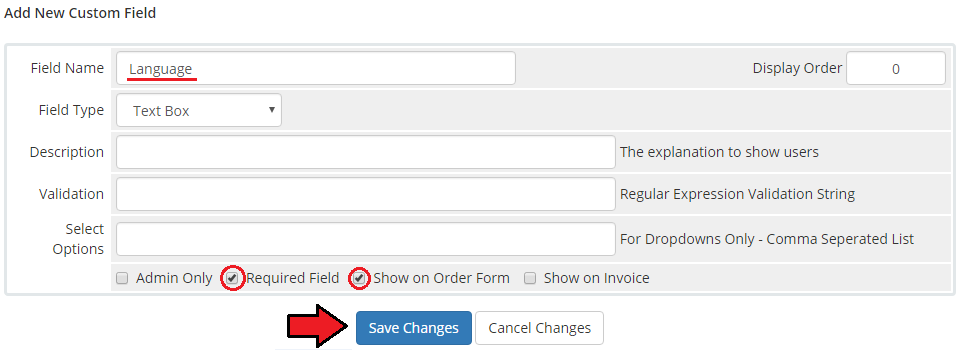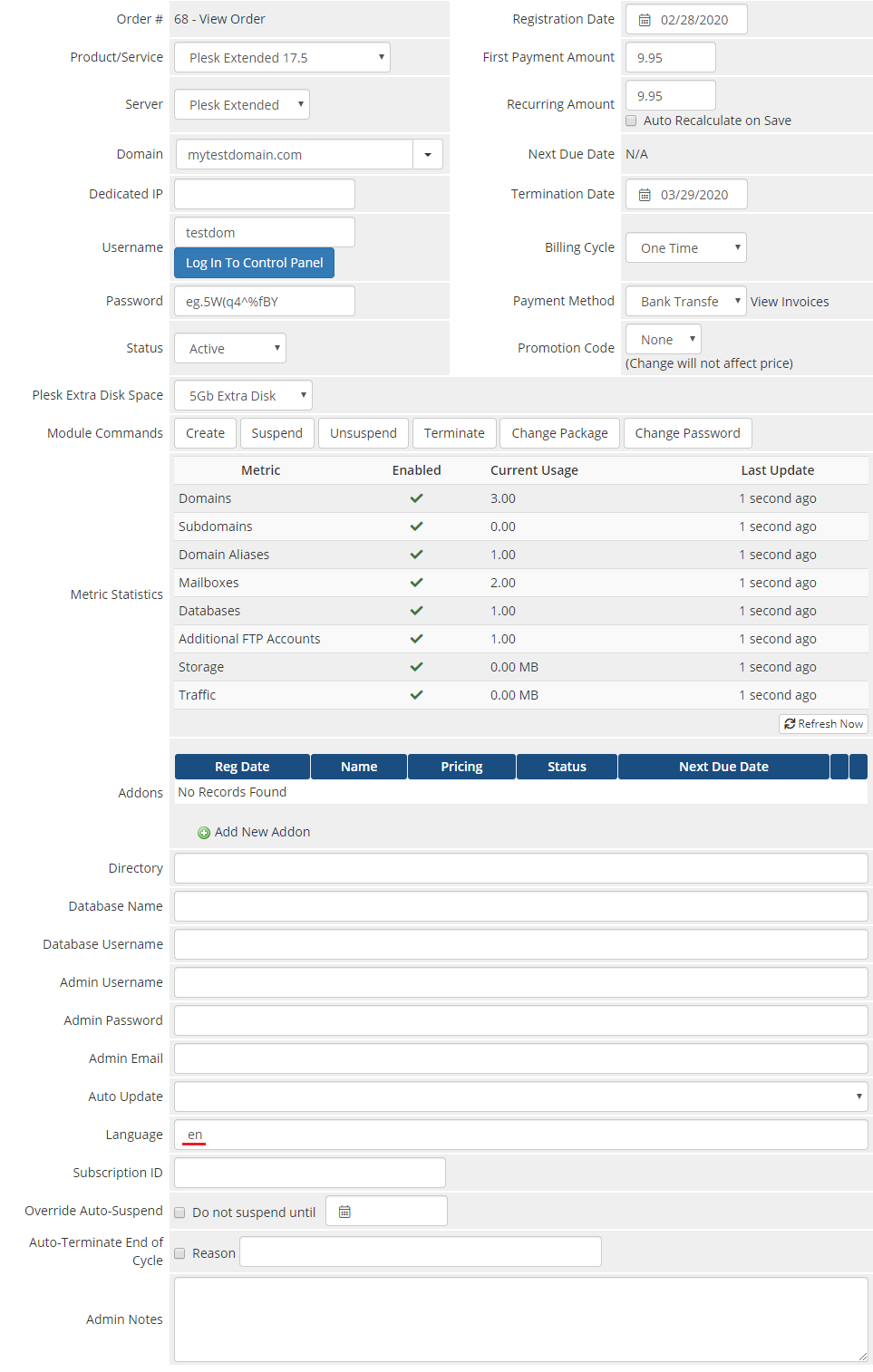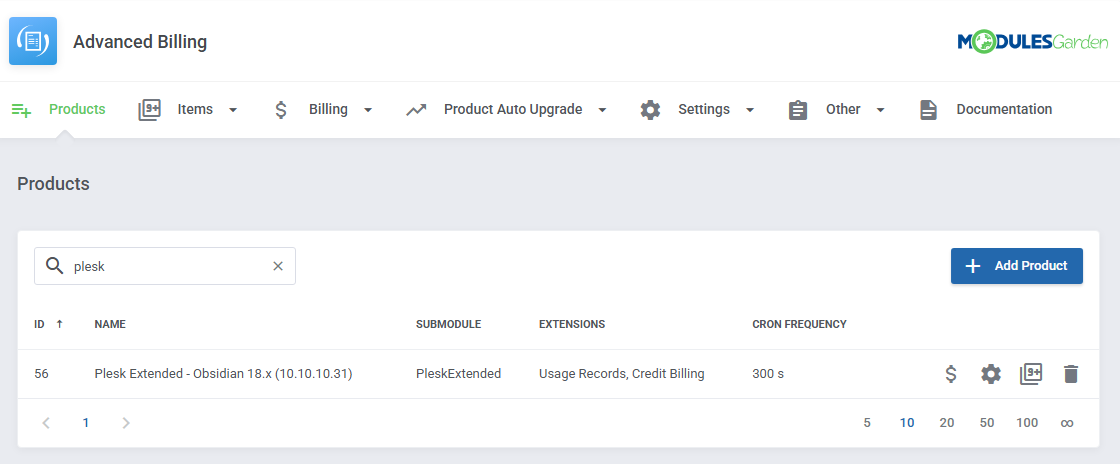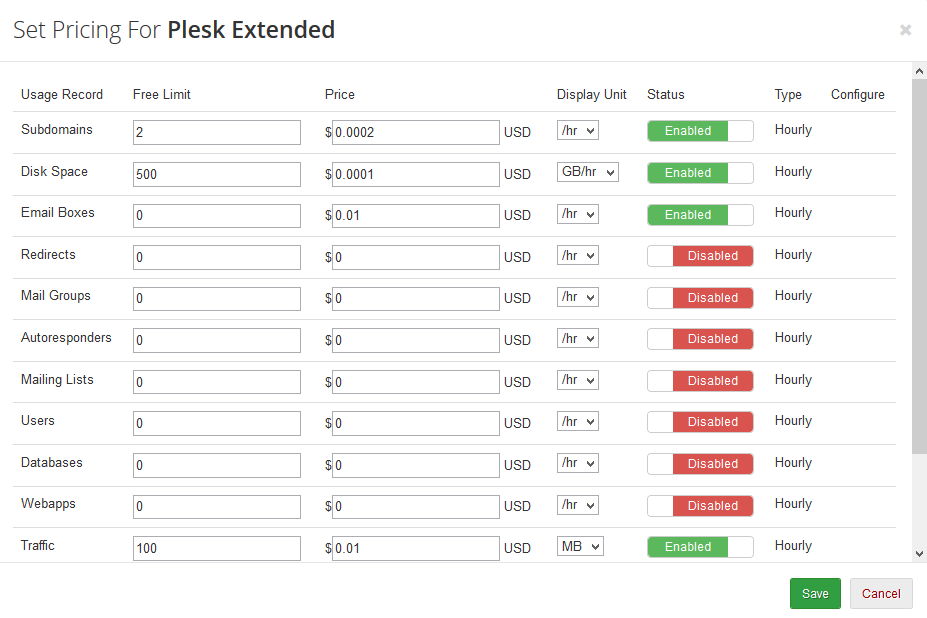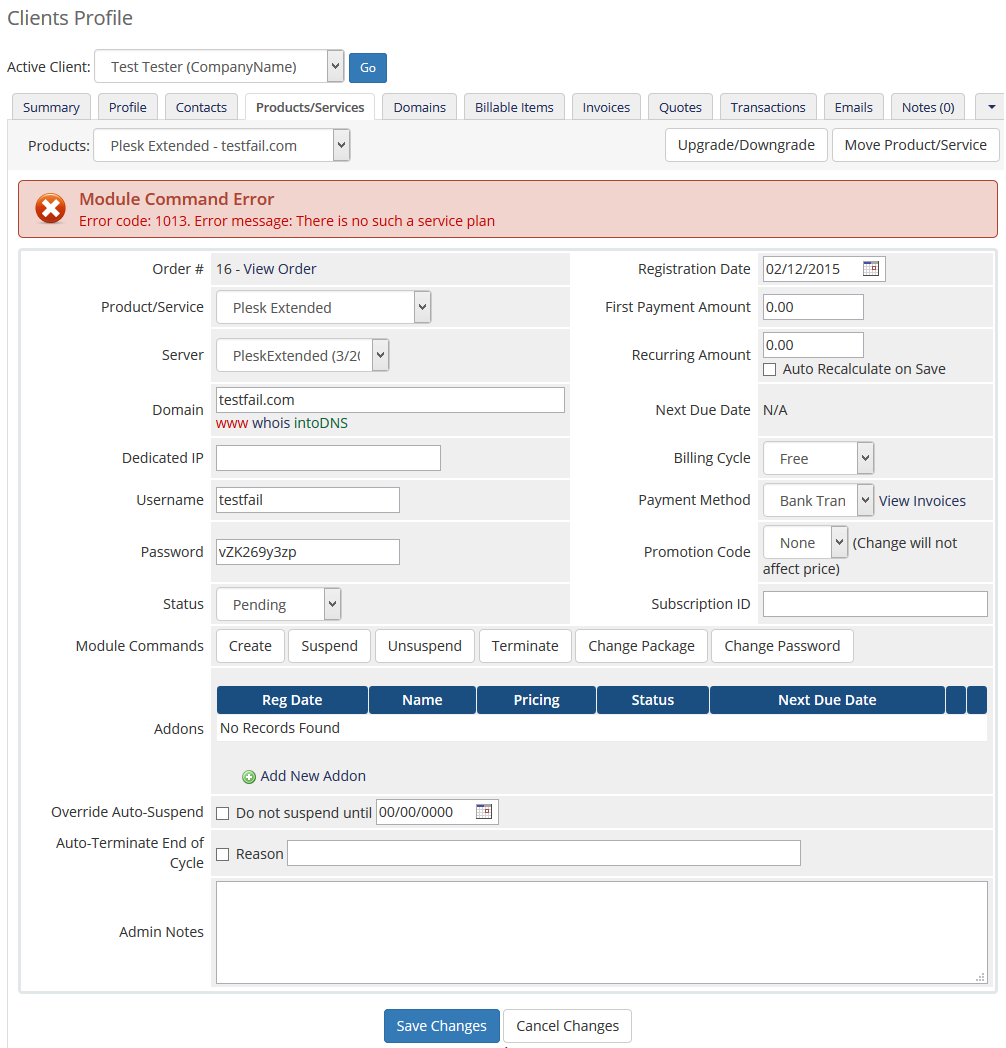Plesk Extended For WHMCS
From ModulesGarden Wiki
(Difference between revisions)
|
|
| Line 351: |
Line 351: |
| | |style="padding: 0px 0px 15px 15px;"|'''24. You are free to leave the application selection issue to your clients to be effected during ordering process by using the '' 'Use Configurable Options' '' switch and choosing the appropriate option from the list. <br /> | | |style="padding: 0px 0px 15px 15px;"|'''24. You are free to leave the application selection issue to your clients to be effected during ordering process by using the '' 'Use Configurable Options' '' switch and choosing the appropriate option from the list. <br /> |
| | Subsequently, you will notice a download button appearing next to the dropdown list. Its purpose is to download the available application list in a text format. <br /> | | Subsequently, you will notice a download button appearing next to the dropdown list. Its purpose is to download the available application list in a text format. <br /> |
| | + | More information about available configurable options and custom fields can be found [[Plesk_Extended_For_WHMCS#Applications_Configuration|here]]. |
| | |} | | |} |
| | {| | | {| |
Revision as of 11:13, 26 May 2017
Article update is ongoing on this page, watch out for broken links and unclear descriptions!
We are sorry for the inconvenience caused.
Plesk Extended For WHMCS is a module which allows your customers to manage their web hosting accounts directly from the client area.
Our product increases your comfort of management and simplifies web hosting account handling for your customers.
Let your web hosting users manage their Plesk accounts in your own WHMCS. Achieve all of these and set it up within a few minutes time!
|
| ✔ Create/Suspend/Unsuspend/Terminate Account
|
| ✔ Change Package And Password Of Account
|
| ✔ Configure Client Area Features Per Product
|
| ✔ Define Service Plan Name Per Product
|
| ✔ Define Reseller Plan Name Per Product
|
| ✔ Enable And Configure Application Auto Installer To Use Per Product - Installatron Or Default Plesk App Installer
|
| ✔ View All Plesk Extended Products In One Place
|
| ✔ View All Plesk Extended Server Configurations In One Place
|
| ✔ Toggle 'Power User' Plesk Panel View
|
| ✔ Define Custom URL Of Panel And Webmail
|
| ✔ Remote Access And Management Of:
|
| ✔ DNS Records - MySQL And PostgreSQL Databases Support
|
| ✔ Change Account Password
|
- Application Auto Installer Features:
| ✔ Auto Install Chosen Application After Account Creation
|
| ✔ Auto Install Application Chosen By Client During Order - With Configurable Options
|
| ✔ Install New Applications With Installatron Or Default Plesk App Installer
|
| ✔ View Installed Applications
|
| ✔ Manage Installed Applications
|
| ✔ Backup Installed Applications
|
| ✔ View And Manage Created Backups
|
| ✔ Restore Applications From Backups
|
| ✔ Utilizes Ajax Loaded Pages
|
| ✔ Supports SSO Into Panel And Webmail
|
| ✔ Integrated With Advanced Billing For WHMCS - Server Resource Usage Billing (read more)
|
| ✔ Integrated With Server Allocator For WHMCS - Automatic Assignment Of Specified Servers To Products (read more)
|
| ✔ Supports Windows & Linux
|
| ✔ Supports Plesk 9 up To Plesk Onyx
|
| ✔ Supports PHP 5.4 Up To PHP 7
|
| ✔ Supports WHMCS Templates Five and Six
|
| ✔ Supports WHMCS V6 and V7
|
Installation and Configuration
Installation
This tutorial will show you how to successfully install and configure Plesk Extended For WHMCS.
We will guide you step by step through the whole installation and configuration process.
|
| 1. Log in to your client area and download Plesk Extended For WHMCS.
|
2. In the downloaded file you will find two packages that support different PHP versions.
As presented on the screen below, the first one is dedicated to PHP 7, while the second one is aimed at PHP 5.4 up to PHP 5.6.
Note: You can check current PHP version in your WHMCS. To do so proceed to 'Utilities' → 'System' → 'PHP Info'.
|
3. Extract the downloaded file and choose the one with the right PHP version. Upload and extract the PHP file into the main WHMCS directory.
The content of PHP version files should look like this.
|
4. When you install Plesk Extended For WHMCS for the first time you have to rename 'license_RENAME.php' file.
File is located in 'modules/servers/pleskExtended/license_RENAME.php'. Rename it from 'license_RENAME.php' to 'license.php'.
|
5. In order to configure your license key you have to edit a previously renamed 'license.php' file.
Enter your license key between quotation marks as presented on the following screen. You can find your license key in your client area → 'My Products'.
|
Activation of Addon
6. Now you have to activate the module in your WHMCS system.
Login to your WHMCS admin area. Click 'Setup' then choose 'Addon Modules'.
Afterwards, find 'Plesk Extended Center' and press 'Activate' button.
|
7. In the next step you need to permit access to this module.
To do so, press 'Configure'. Afterwards, select required administrator roles and press 'Save Changes'.
Note: Here you can also define which system template you are using, '5' or '6'.
|
8. You have just successfully installed Plesk Extended For WHMCS!
|
Configuration of Server
9. Now, we will show you how to configure a new server.
To do so, log in into your WHMCS. Press 'Setup' → 'Products/Services' → 'Servers'. Afterwards, press 'Add New Server'.
|
10. Next, enter your server name, IP address, username and password. Choose 'PleskExtended' from a dropdown menu and press 'Save Changes'.
Here you can also provide other server details like nameservers or maximum number of accounts.
|
11. After you configure your server correctly, you will see a following screen.
Now, you need to create a new group for your server. For that purpose press 'Create New Group'.
|
| 12. Enter name, click on your previously created server, press 'Add' then 'Save Changes'.
|
Configuration of Product
13. In order to create and configure the product, click on 'Setup' → 'Products/Services' → 'Products/Services'.
If you do not have a product group, 'Create a New Group'.
|
| 14. Enter product group name and press 'Save Changes'.
|
15. When you have a product group, you can create your product and assign it to Plesk Extended.
To create a product press 'Create a New Product'.
|
16. Afterwards, choose your product type and product group from dropdown menus, enter your product name and press 'Save Changes'.
Please note that you may select only between 'Hosting Account' and 'Reseller Account' when choosing the product type as only those are supported by Pelsk module.
|
17. Now, move to 'Module Settings' section, choose both 'PleskExtended' and your previously created server group from dropdown menus.
Remember to add your 'Client Template Name' or 'Service Plan Name'. Plesk Extended will not work properly without specified plan name.
Decide on the way Plesk will assign IP addresses in the accounts creation process, using the 'IP Address Types' dropdown list.
Here you may also enable 'Power User' view. Don't forget to 'Save Changes' .
|
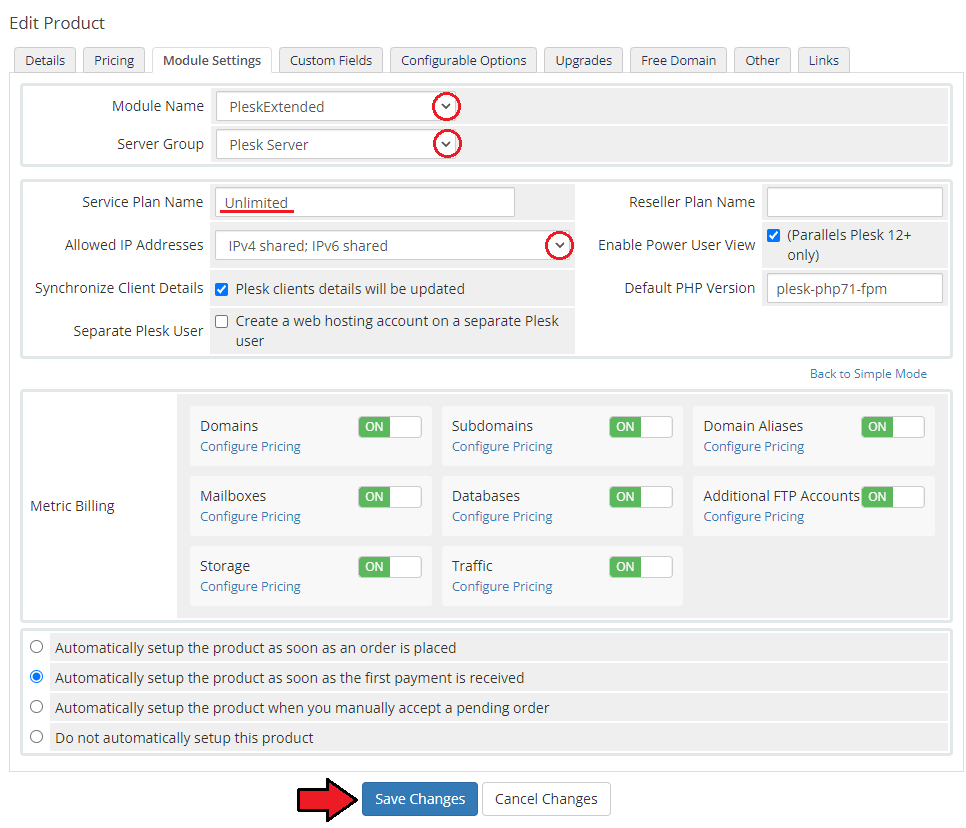
|
18. At the end of the product configuration process, make sure you add a cron job as presented below (each 10 minutes suggested).
Its purpose is to download requested backups from Plesk to your WHMCS server which can subsequently be downloaded by the clients.
php -q /your_whmcs/modules/servers/pleskExtended/cron.php
Do not forget to replace 'your_whmcs' with your WHMCS root location.
The cron can be also run each few minutes in order to perform the action more often.
|
| 19. Good job! You have just correctly created and customized new product which will appear in Plesk Extended Center admin area.
|
Configuration of Addon
19. You have just correctly created and customized a new product.
Go to 'Addons' → 'Plesk Extended Center' in your WHMCS.
You will find there dashboard with a short guide where you will find a few steps described to start your successful work with our module.
There are also precise data on available products and servers:
- see the number of active/suspended/terminated products
- check the number of active accounts
- log into panel
- upgrade your Plesk products
- press 'Documentation' tab to be moved to this very site!
|
20. Proceed to 'Features' section and find the product you are interested in.
Press 'Configuration' button next to it to continue.
|
21. You should find there a box dedicated to 'Features'.
If you have already another product configured, you may copy its configuration now. Find one more box 'Copy Configuration From' and choose product from dropdown menu.
To show you an example, we will set the configuration from the beginning, we will not use other product's configuration.
Select the features you would like to activate for your customers.
|
22. Next toggle 'Install Application' that will be used to install applications by your clients.
In 'Autoinstaller Type' you may choose between 'Installatron' and 'Default' autoinstaller.
|
23. You may also introduce installing one of the selected applications automatically, once an order is created.
Use 'Auto Install Chosen App on Create' switch and select the default option from the 'Apps / Configurable Options' list.
|
24. You are free to leave the application selection issue to your clients to be effected during ordering process by using the 'Use Configurable Options' switch and choosing the appropriate option from the list.
Subsequently, you will notice a download button appearing next to the dropdown list. Its purpose is to download the available application list in a text format.
More information about available configurable options and custom fields can be found here.
|
25. In the next step, move to 'Server Configuration' to set up connection.
Press ' Configuration' button next to a desired server.
|
| Enter proper domains or IP addresses to allow connection with Plesk panel and Webmail accordingly.
Do not forget to 'Save' changes once it is ready!
|
26. From now on, all your clients who ordered a previously created product will be able to manage their Plesk accounts via your WHMCS system.
Here is a view of the ordered product summary in admin area. Available actions:
- Log In To Control Panel
- Use Module Commands: 'Create', 'Suspend', 'Unsuspend', 'Terminate' the product; 'Change Package' and 'Change Password'.
|
Management
Plesk Extended allows your customers to manage their accounts via client area in your WHMCS system.
In this short guide we will present you the management possibilities of our module.
|
Client Area
FTP Access
In the very first section you are given the possibility to manage your FTP access or create a new FTP accounts.
FTP access management is dependent on the system your Plesk panel is set up on.
In case of Windows system used, you may add new accounts, change passwords and delete old accounts.
However, in case of Linux system (see the screen below) only changing passwords is allowed.
|
Backups
All backups made are displayed under the 'Backups' section.
To create a new backup add prefix, desctiption, choose split size and backup types.
To download the backup, the client creates a query which will prepare the backup first. The backup will be downloaded from Plesk to the WHMCS server on the next cron execution.
After preparation the backup will be marked in green and available for download by the client.
|
Email Addresses
| You can manage all aspects related to e-mail accounts. Add new accounts, search through accounts and remove useless ones.
|
Email Forwarders
| Take any advantage of 'Email Forwarders' functionality. Send a copy of all mail from one email address to another.
|
Spam Filter
| The 'Spam Filter' powered by SpamAssassin is designed to identify spam messages among emails sent to mailboxes hosted on your Plesk server.
|
|
Enable and configure the filter as desired for the selected mailbox. You can also adjust sensitivity which ranges from 2 to 12.
If mailboxes receive lots of spam messages with the current setting, to make filter more sensitive, try setting a lesser value, for example, 6.
If they are missing email because spam filter thinks they are junk, try reducing filter sensitivity by setting a higher value, for example, 8.
|
Databases
Owing to 'Databases' management you can create/delete new databases and users.
To create a new database, type in its name, into an appropriate field and select its type.
Please note that 'MySQL' and 'PostgreSQL' databases are currently supported.
|
You can also add users to particular databases. Remember that you may always use secure password generator while creating a user.
Use action buttons to delete useless users or change their password.
|
Subdomains
Create subdomains to access different parts of your website. Choose domain from your list of available and provide document root.
You may always remove unused subdomain.
|
Addon Domains
You can also add and manage addon domains.
Choose hosting type (with or without hosting) and press 'Add'.
Make sure this feature is allowed for your account before using!
|
Domain Aliases
Add and manage domain aliases to allow redirections of web contents display to other webpage.
Select available options and press 'Add'.
|
DNS Settings
Add records by providing their hostname and value, select type of such record.
Underneath you will find a full list of existing records.
|
Applications
Use Plesk Extended For WHMCS to install your favorite applications in a few seconds without even accessing Plesk panel! To start, simply proceed to 'Applications'
then find 'Install New' section.
Important: below we are presenting a sample flow of installing application with an 'Installatron' auto installer.
The process itself differ slightly and some of options may not be available for 'Default' Plesk autoinstaller.
For more info please refer to features list here.
|
Afterwards, you will see an extensive list of all applications. For presentation purposes we will install 'osTicket'.
Find 'osTicket' and press it.
|
| Now, you have to enter necessary installation details and then press 'Install Application' to follow. Wait for 'Success' message.
|
View the list of your installed applications by clicking 'Installed Applications' tab. Please press 'Refresh Table' button to see the latest installed application!
You will see there entered while installing 'Site Name', version of installed app and allowed actions.
'Delete' (2) installed application or prepare a backup (1) of the application. More about 'Backups' below.
|
This is how the list looks like when 'Default' Plesk autoinstaller has been used.
Please note that there are no actions allowed on the installed application and there is no 'Backups' option.
|
Backups
If 'Installatron' autoinstaller type is used, then 'Backups' option is available.
To backup an application simply press adequate action button next to it.
|
| Confirm the action and wait a moment until your backup is ready.
|
Move to 'Backups' tab. There is a list of all created backups.
Use action buttons to restore (1) backup or to delete (2) it.
|
Web Users
| Add and manage a list of web users that have personal pages on your website.
|
SSL Certificates
This section will allow you to generate or paste ready SSL certificates and private keys.
Simply choose 'Generate' or 'Paste' and then fill out required fields. Once ready, you will see a list of ready certificates on the list below.
|
One Click Login
Log In To Panel
With a single click of a button 'Log In To Panel' you can be redirected to your Plesk Panel account.
Note that you must have a proper IP address or domain entered in admin area panel to use this button.
|
Log In To Webmail
You can quickly access your webmail through pressing 'Log In To Webmail' button.
Note that you must have a proper IP address or domain entered in admin area panel to use this button.
|
Applications Configuration
Configurable Options For Application Auto Install
Let your clients decide which application they would like to install on their new Plesk account.
While placing an order your customer chooses an application and along with account creation this very application will be installed on the account.
There is nothing else you need to do. Application will be instantly ready to use!
To set up this feature, come back to your product's configuration, find 'Applications' section, activate 'Install Applications' , choose 'Auto Installer' and activate 'Use Configurable Options' .
Click on a download icon to view the list of applications.
|
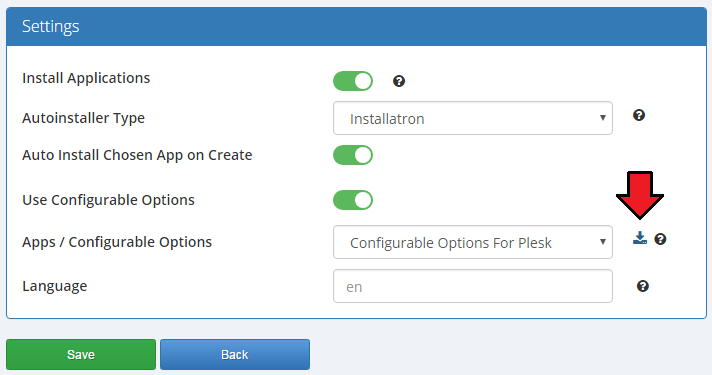
|
These are the names of values that you can enter in configurable options' fields, we will configure them in the next step.
For example, if you would like to set up 'Drupal' in your applications list, you will need to enter value 'Drupal 8.3.2' or 'Drupal'.
1. If you have made a mistake with the application name, the auto installer will not work.
2. If you do not enter version number, the auto installer will install the latest version of the application.
Now, when you know what values should be entered in configurable options for particular applications, we can proceed further.
|
| Go to your 'WHMCS' → 'Setup' → 'Products/Services' → 'Configurable Options' and press 'Create a New Group' .
|
| Enter 'Group Name' of your choice, select product you want to assign configurable options to, then press 'Save Changes' .
|
| Now click on 'Add New Configurable Option' .
|
This moment is very important. As 'Option Name' , you have to enter 'Installation App' . Otherwise the entire functionality will not work.
Here you can set up as many applications as you want. To do so, enter a value name e.g. 'Wordpress 4.7.5' and press 'Save Changes' .
Repeat this as many times as you need and do not forget to set 'Option Type' to 'Dropdown' .
Remember that you are not obliged to type in the application version number! If not provided, the latest version will be installed.
|
As you can see on the following screen we decided to offer our customers 5 applications.
When you finish adding applications, press 'Save Changes' and 'Close Window'.
|
From the module's version 3.1.0 you can also create a new configurable option Auto Backup On Update with the 'Yes/No' option type.
This option is used to enable the creation of auto update backups for a firstly chosen application after the initial order in WHMCS.
Please note that this option works only with Installatron plugin and Auto Update Backup Enabled By Default On Order setting in the module addon features has to be disabled to make this configurable option work properly.
|
Afterwards, come back to 'Plesk Extended Features' → 'Configuration' → 'Applications' , activate 'Use Configurable Options' and choose 'Apps/Configurable Options' from a dropdown menu.
Please note that you can have more configurable options groups. Press 'Save' and that's it. You have just successfully assigned configurable options to application autoinstall.
|
Let's check out what your customers are going to see in their client area while placing the order.
As you can see, a dropdown menu with previously configured applications has shown up.
|
Assignment of Custom Fields To Application Autoinstall
Now, when you know how to allow your customers to choose which application they would like to install on their account, we can proceed one step further.
Until that moment applications had been installed with use of default details like e.g. directory names or database name.
Those details are sent to each customer's email.
Allowing your customers to choose their own installation paths, usernames and others is a safer and recommended solution.. Let's see how can we do that.
In the beginning, go to 'Product/Services' , find your product using 'Plesk Extended' module and enter 'Custom Fields' category.
You will need to add 12 custom fields, the first 8 are:
- Directory
- Database Name
- Database Username
- Database Password
- Table Prefix
- Site Name
- Site Description
- Language
Remember to set each field type as 'Text Box' , tick 'Required Field ' and 'Show on Order Form'.
Everything is shown on the screen below.
|
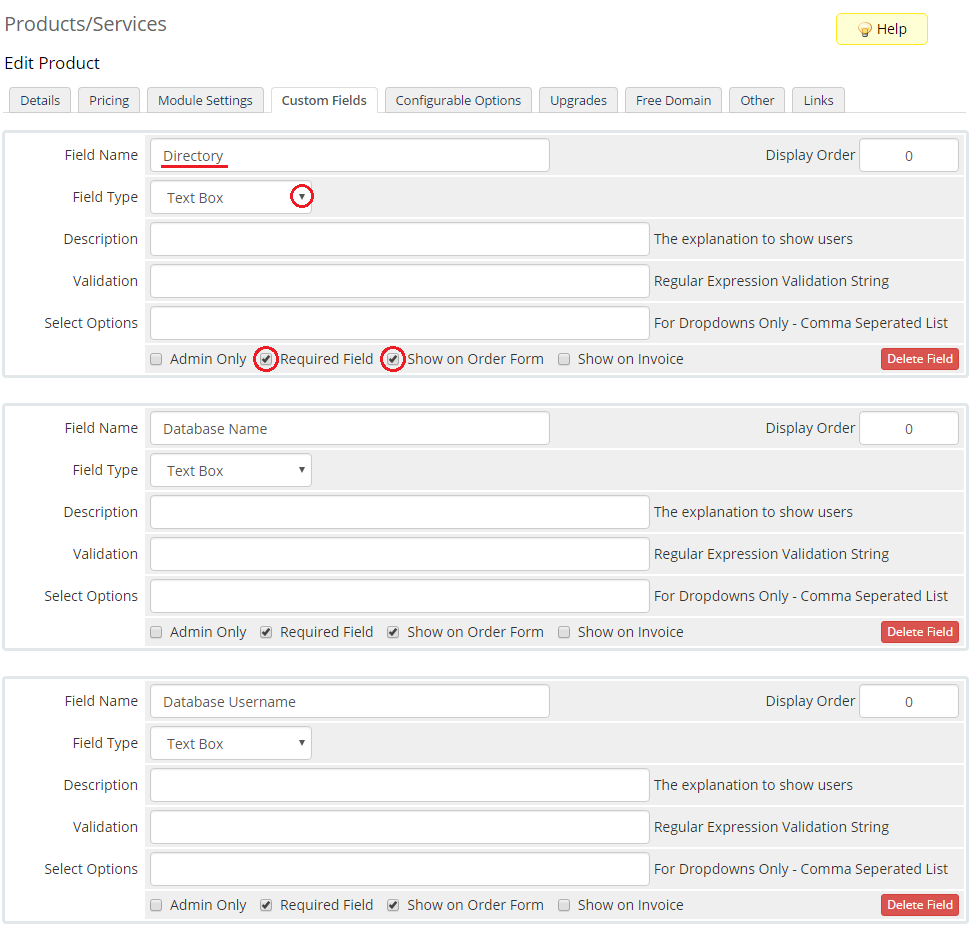
|
The next 3 fields are:
- Admin Username
- Admin Password
- Admin Email
Set them as 'Text Box' and tick 'Show on Order Form'.
|
| The last field is:
Set it as 'Drop Down' , enter 'Yes, No' into 'Select Options' , tick 'Required Field ' and 'Show on Order Form'.
|
Once you add all the custom fields they will appear while placing an order.
Voila! Now your customers can personalize each application without the necessity of installing it later.
|
Custom Installatron Application Language
We will show you how to quickly set custom language for Installatron web applications.
For this purpose you need to add a new custom field for your product. The field should be called 'Language' .
|
Afterwards go to your 'Products/Services' and check whether 'Language' field has appeared.
In order to change default applications language for certain account enter here an appropriate value.
|
From now on the new field will be visible for your customers as well. While installing a new application they can choose desired language by entering value into the field.
Here you will find a complete list of language codes.
|
Management of Existing Products
You can easily use Plesk Extended module with your already configured Plesk products.
To do so change the type of servers and module names of products from 'Plesk' to 'PleskExtended'.
Additional information about how to correctly configure your servers and products can be found at points 8-16 of 'Installation and Configuration' section.
|
Billing Management
| The module allows you to charge your customers basing on the server resources used by them.
|
| With Advanced Billing module, you can also display your customers the current server resource usage and their cost.
|
Tips
| 1. 'Login To Webmail' button address: 'http(s)://webmail.{domain_from_order}'.
|
2. To set up an existing customer's account in your Plesk Extended, create a new WHMCS order with the same username, password and email address.
Then set the account status to active.
|
| 3. As this module supports templates system, any changes made in the module's templates files will be saved after the upgrade process.
|
Common Problems
| 1. When you have problems with connection, check whether your SELinux or firewall does not block ports.
|
2. If you see an error as shown on the screen below, it means that you haven't provided your service plan name or reseller plan name in product's 'Module Settings'.
Once you enter the name, the problem will disappear.
|
3. If you are unable to connect with your Plesk server or client area functionalities don't work properly, then make sure that you are connecting with your server on port 8443.
Here you can find more information on how to change default port in Linux and Windows
|
4. Unable to get the version number from the server. CURL Error: 7 - couldn't connect to host. Check server connection details.
Check connection details and the connection itself between WHMCS and server.
|
5. Unable to get the version number from the server. Permission denied. You have to set admin account access details.
You need admin account access to use PPPE module, reseller account API is not supported.
|
6. Blank page at 'Applications'.
Reason: Some libraries may be missing.
Solution: Make sure you have installed php-xml library.
|
7. If you have problems with your license, please make sure that the content of the file is correct.
Please note that for Plesk Extended For WHMCS V2.0.0 and later the license key begins with:
$plesk_extended_licensekey="ModulesGarden_PleskEX_LicenseKey";
Not as it was for the previous versions:
$parallels_plesk_panel_extended_licensekey="ModulesGarden_PleskEX_LicenseKey";
|
8. In case you see an error: 'Request Is Invalid: Error In Line 5: Element 'owner-id' is not a valid value of the atomic type 'int'.' while creating the product, please verify your product type.
Most probably it is set to 'Dedicated/VPS Server' or 'Other' which are not supported. See point 15 for more info.
|
9. If you see an error simillar to: 'Unable to find appropriate manager for this version of Panel. Plesk should be at least 8.0 version.' while creating the product please verify your server configuration.
Make sure that you have SSL 'Secure' ticked in your server configuration, depending on your Plesk settings.
|
|
